LG Electronics USA F7200 Dual-Band GSM Phone User Manual F7250 1220
LG Electronics USA Dual-Band GSM Phone F7250 1220
Users Manual
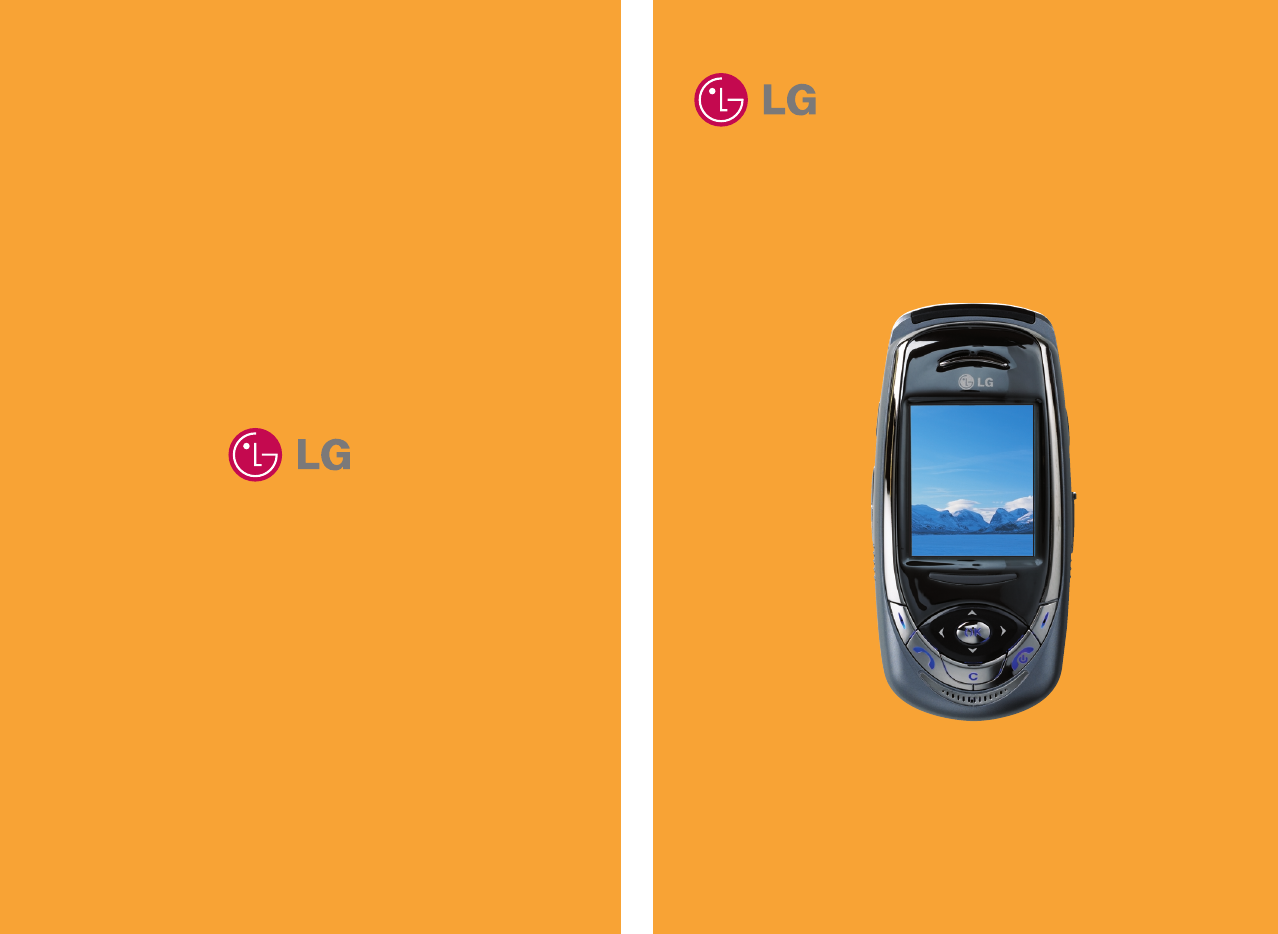
F7200
User Guide
F7200
User Guide
MMBB0148601 (1.0)
Some of contents in this manual may differ from your phone depending on the
software of the phone or your service provider.

F7200
User Guide

Unpacking 8
For Your Safety 9
Your Phone 13
Phone Components 13
Your Phone’s Features 14
Display Information 16
Getting Started 18
Installing the SIM Card 18
Charging the Battery 21
Turning Your
Phone On and Off 23
Access Codes 24
Barring Password 24
General Functions 25
Making a Call 25
Making a Call by Send Key 25
Making International Calls 25
Ending a Call 25
Making a Call
From the Contact List 26
Adjusting the Volume 26
Answering a Call 26
Vibrate Mode (Quick) 27
Signal Strength 27
Entering Text 27
Selecting Functions
and Options 32
Address Book 33
In-Call Menu 34
During a Call 34
Making a Second Call 34
Swapping Between Two Calls 34
Answering an Incoming Call 34
Rejecting an Incoming Call 35
Muting the Microphone 35
Multiparty or
Conference Calls 35
Making a Second Call 35
Setting Up a
Conference Call 36
Activate the
Conference Call on Hold 36
Adding Calls to the
Conference Call 36
Private Call in a
Conference Call 36
Ending a Conference Call 36
Menu Tree 37
Recent Calls 40
Missed Calls 40
Dialed Calls 40
Received Calls 40
4
Table of Contents

5
Delete Recent Calls 41
Call Durations 41
Last Call 41
Received Calls 41
Dialed Calls 41
All Calls 41
Data Information 42
WAP Information 42
External Device 42
Total Data 42
Messaging 43
Text Messages 43
Write Message 43
Inbox 44
Outbox 45
Drafts 45
Settings 45
Delete All 46
Instant Messaging 47
Login(Sign On/Connect) 47
Saved Conversations 47
Settings 48
IM Provider 48
Multimedia Messages 54
Write Message 54
Inbox 55
Outbox 56
Drafts 57
Settings 58
Voice Mail 59
Listen to Voice Mail 59
Voice Mailbox Number 59
Download Messages 60
Inbox 60
Receive 60
Templates 61
Text 61
Multimedia 61
Business Card 62
Memory Status 62
Games & Apps 63
Shop Games 63
Games & Apps 63
Bookmarks 64
View Information 65
Memory Status 65
Java Version 65
MEdia Net 66
MEdia Home 67
Bookmarks 67
Go To URL 68
Access Point 69

6
Cache Settings 70
Clear Cache 70
Cache Check 70
Security Certificates 70
WAP Information 70
MEdia Mall 71
Shop Ringtones 71
Shop Games 71
Shop Graphics 71
Shop MMS 71
Shop Applications 71
MEdia Home 71
PTT 72
My MEdia 85
Bookmarks 85
Games & Apps 85
Ringtone/Audio 85
Graphics 86
Multimedia Contents 86
Tools 87
Alarm Clock 87
Calendar 88
Voice Recording 89
Calculator 90
Memo 90
World Time 91
Unit Converter 92
Address Book 93
Contact List 93
New Contact 94
Speed Dials 94
Voice Tag List 95
Caller Groups 96
Copy All 97
Delete All 97
Set Memory 97
Information 98
Settings 99
Sounds 99
Shop Ringtones 99
Ringtones 99
Volume 99
Message Alert Tones 99
Key Tones 99
Voice Recording 100
Display 100
My Wallpaper 100
Backlight 100
Languages 100
Menu Style 101
Date & Time 101
Set Date 101
Date Format 101
Set Time 101

7
Time Format 101
Auto Update 101
Call Settings 102
Call Forwarding 102
Answer Mode 103
Send My Number 103
Call Waiting 103
Minute Minder 103
Voice Dial 103
Auto Redial 104
Closed User Group 104
TTY 105
Send DTMF 105
Security 106
PIN Code Request 106
Fixed Dial Number (FDN) 106
Change Codes 107
Connection 107
Network Selection 107
World Phone 108
GPRS Attach 108
Access Point 108
Reset Access Point 108
Reset Setting 109
Q & A 110
Safety Guidelines 113
Glossary 117
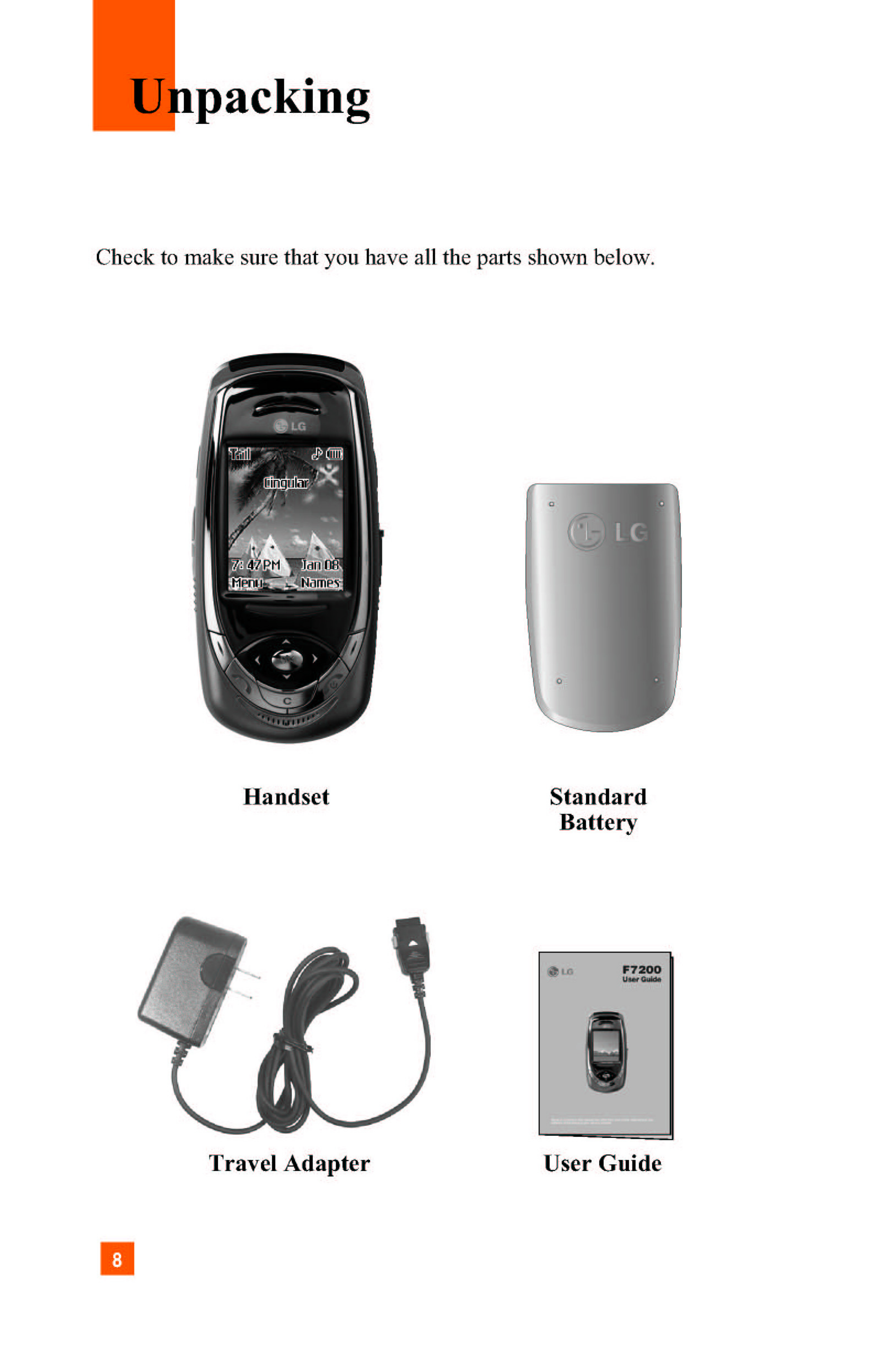

9
Important Information
This user guide contains important information on the use and operation of
this phone. Please read all the information carefully for optimal
performance and to prevent any damage to, or misuse of, the phone. Any
changes or modifications not expressly approved in this user guide could
void your warranty for this equipment.
Before You Start
Safety Instructions
WARNING! To reduce the possibility of electric shock, do not expose
your phone to high humidity areas, such as the bathroom, swimming pool,
etc.
Always store your phone away from heat. Never store your phone in
settings that may expose it to temperatures less than 32°F or greater than
104°F, such as outside during a snowstorm or in your car on a hot day.
Exposure to excessive cold or heat will result in malfunction, damage
and/or catastrophic failure.
Be careful when using your phone near other electronic devices. RF
emissions from your mobile phone may affect nearby inadequately
shielded electronic equipment. You should consult with manufacturers of
any personal medical devices such as pacemakers and hearing aides to
determine if they are susceptible to interference from your mobile phone.
Turn off your phone in a medical facility or at a gas station.
Never place your phone in a microwave oven as this will cause the battery
to explode.
Safety Information
Please read and observe the following information for the safe and proper
use of your phone and to prevent any unanticipated damage. Also, keep the
user’s manual in an accessible place at all times after reading it.
For Your Safety

10
]
Unplug the power cord and charger during a lightning storm to avoid
electric shock or fire.
]
Do not use your phone in high explosive areas as the phone may
generate sparks.
]
Do not put your phone in a place subject to excessive dust, and keep the
minimum required distance between the power cord and heat sources.
]
Do not damage the power cord by bending, twisting, pulling, or
subjecting it to heat. Do not use the plug if it is loose as it may cause fire
or electric shock.
]
Hold the power cord plug firmly to plug and unplug the power cord.
Ensure the plug is firmly connected. If it is not firmly connected, it may
cause excessive heat or fire.
]
Do not place a heavy item on the power cord. Do not allow the power
cord to be crimped as it may cause fire or electric shock.
]
Be careful not to let the battery contact metal conductors such as a
necklace or coins. When shorted, it may cause an explosion.
]
Do not disassemble or impact the battery as it may cause electric shock,
short-circuit, and fire. Store the battery in a place out of reach of children.
]
Using a damaged battery or placing a battery in your mouth may cause
serious injury.
]
Do not place items containing magnetic components such as a credit
card, phone card, bank book or a subway ticket, near your phone. The
magnetic strip can be damaged by the phone.
]
Do not hold or let the antenna come in contact with your body during a
call.
]
Talking on your phone for a long period of time may reduce the call
quality due to heat generated during the use of the phone.
]
Do not allow excessive vibration or impact to the phone.
For Your Safety

11
]
When you do not plan to use the phone for a long period of time, store it
in a safe area with the power cord unplugged.
CAUTION
Use only the supplied and approved antenna. Use of unauthorized antennas
or modifications could impair call quality, damage the phone, void your
warranty and/or result in violation of FCC regulations.
Do not use the phone with a damaged antenna. If a damaged antenna
comes into contact with skin, a minor burn may result. Contact your local
dealer for a replacement antenna.
Body-worn Operation
This device was tested for typical body-worn operations with the back of
the phone kept 0.79 inches (2.0cm) between the user's body and the back of
the phone. To comply with FCC RF exposure requirements, a minimum
separation distance of 0.79 inches (2.0cm) must be maintained between the user’s
body and the back of the phone. Third-party belt-clips, holsters, and similar
accessories containing metallic components should not be used. Body-worn
accessories that cannot maintain 0.79 inches (2.0cm) separation distance
between the user’s body and the back of the phone, and have not been
tested for typical body-worn operations may not comply with FCC RF
exposure limits and should be avoided.
Vehicle Mounted External Antenna (optional,
if available)
A minimum separation distance of 8 inches (20 cm) must be maintained
between the user/bystander and the vehicle mounted external antenna to
satisfy FCC RF exposure requirements.
For more information about RF exposure, visit the FCC website at
www.fcc.gov
For Your Safety

12
FCC Part 15 Class B Compliance
This device and its accessories comply with part 15 of FCC rules.
Operation is subject to the following two conditions: (1) This device and
its accessories may not cause harmful interference, and (2) this device and
its accessories must accept any interference received, including
interference that may cause undesired operation.
Cautions for Battery
]
Do not disassemble.
]
Do not short-circuit.
]
Do not expose to high temperature: 60°C (140°F).
]
Do not incinerate.
Battery Disposal
]
Please dispose of your battery properly or bring to your local wireless
carrier for recycling.
]
Do not dispose in fire or with hazardous or flammable materials.
Adapter (Charger) Cautions
]
Using the wrong battery charger could damage your phone and void
your warranty.
]
The adapter or battery charger is intended for indoor use only.
Do not expose the adapter or battery charger to direct sunlight or use it in
places with high humidity, such as the bathroom.
For Your Safety
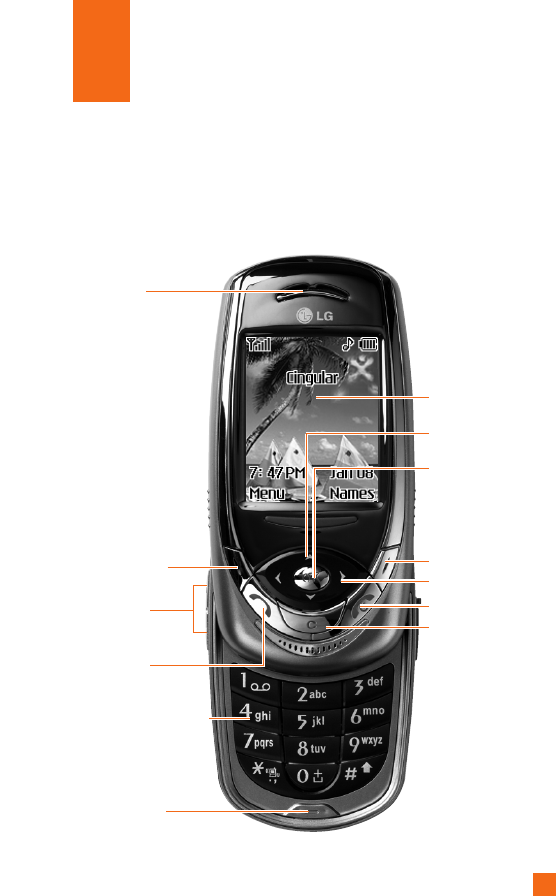
13
1. Earpiece
7. Display screen
8. Navigation key
2. Left soft key
3. Side keys
4. Send key
9. Confirmation key
10. Right soft key
11. Message key
13. Clear key
12. End / Power key
6. Microphone
5. Alpha numeric keys
Phone Components
Your Phone

14
Your Phone’s Features
1. Earpiece
2,10. Left soft key/Right soft key: Each of these keys
perform the functions indicated by the text on the display immediately
above them.
3. Side keys: These keys are used to control the volume of ringtone in
standby mode and speaker volume during a call.
4. Send key: You can dial a phone number and answer incoming calls.
Press this key in standby mode to quickly access the most recent
incoming, outgoing and missed calls.
5. Alphanumeric keys: These keys are used to dial a number in standby
mode and to enter number or characters in edit mode.
6. Microphone: Can be muted during a call for privacy.
7. Display screen: Displays phone status icons, menu items, Web
information, pictures and more in full color.
8. Navigation key: Use for quick access to phone functions.
9. Confirmation key: Long press will launch the WAP browser. Allows
you to select and confirm menu options.
11. Message key: Use to retrieve or send text messages.
12. End/Power key: Allows you to power the phone on or off, end calls, or
return to Standby Mode.
13. Clear key: Allows you to delete the characters entered or return you to
the previous screen.
Your Phone
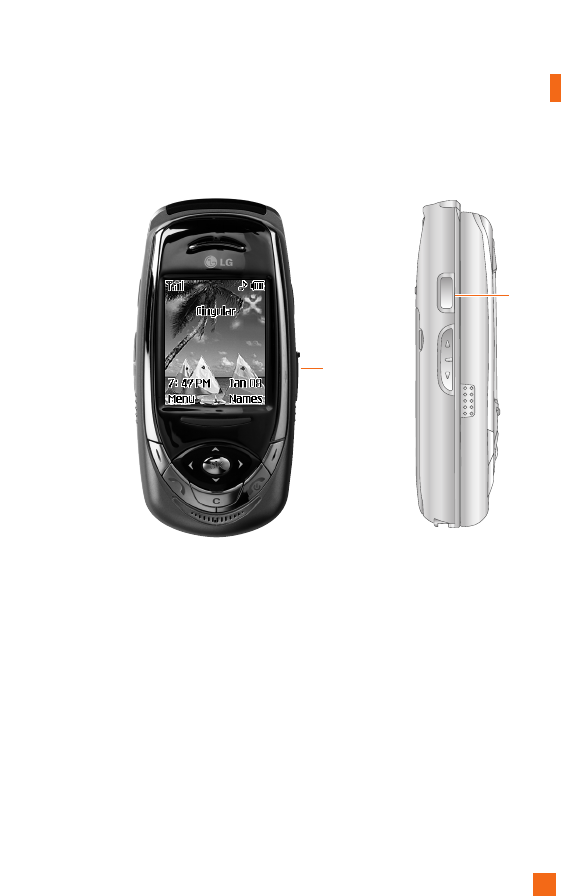
15
Your Phone
Ear-
microphone
jack
PTT
Backlight
A backlight illuminates the display and the keypad. When you press any
key or open the folder, the backlight turns on. It turns off if no key is
pressed within a given period of time, depending on the Backlight menu
option. After one minute, the display turns off to conserve your battery
power. To specify the length of time the backlight is active, set the
Backlight menu option (Menu 9.2.2). See page 96 for further details.
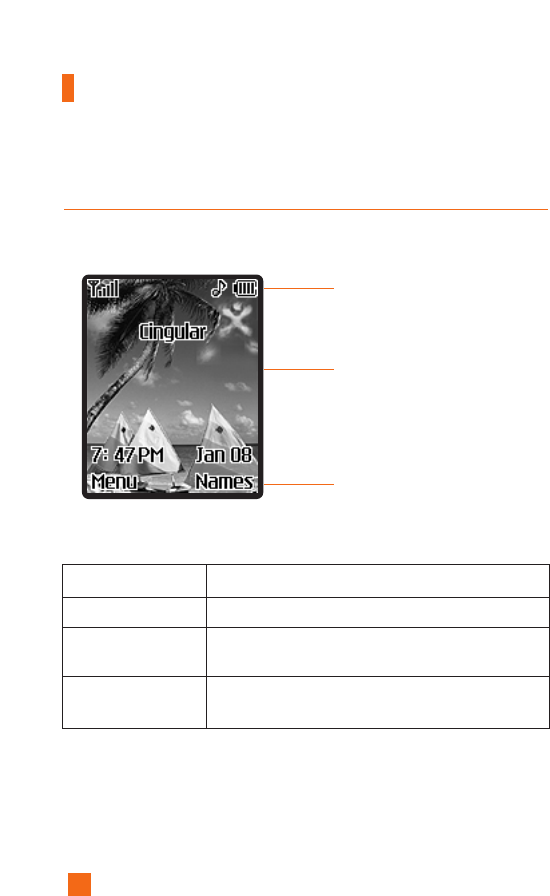
16
Icon area
Text and
graphic area
Soft key
indications
Display Information
Your Phone
Area Description
First line Displays various icons. See page 17
Middle lines Dispaly messages, instructions and Any information that
you enter, such As number to be dialed.
Last line Shows the functions currently Assigned to the two soft
keys.
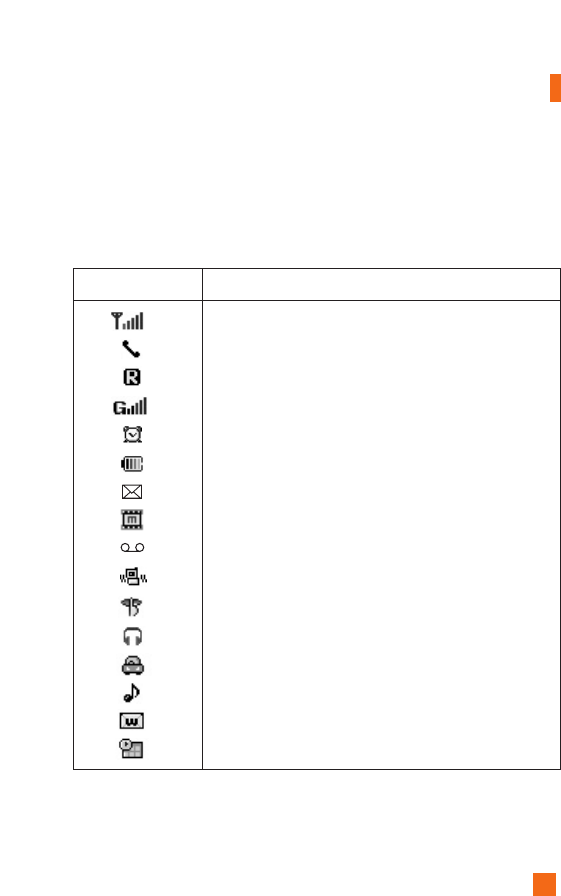
17
Your Phone
On-Screen Icons
The table below describes various display indicators or icons that appear
on the phone’s display screen.
Icon Description
Indicates the strength of the network signal.
Indicates a call is in progress.
Indicates that you are roaming off the network.
Indicates that GPRS service is available.
Indicates the alarm has been set and is on.
Indicates the status of the battery charge.
Indicates the receipt of a text message.
Indicates the receipt of a MMS message.
Indicates the receipt of a voice mail.
Indicates that the vibration ringer has been set.
Indicates the Quiet menu in Profiles.
Indicates the Headset menu in Profiles.
Indicates the Car menu in Profiles.
Indicates the General menu in Profiles.
Indicates that you can use the download message service.
Indicates the Schedule function.
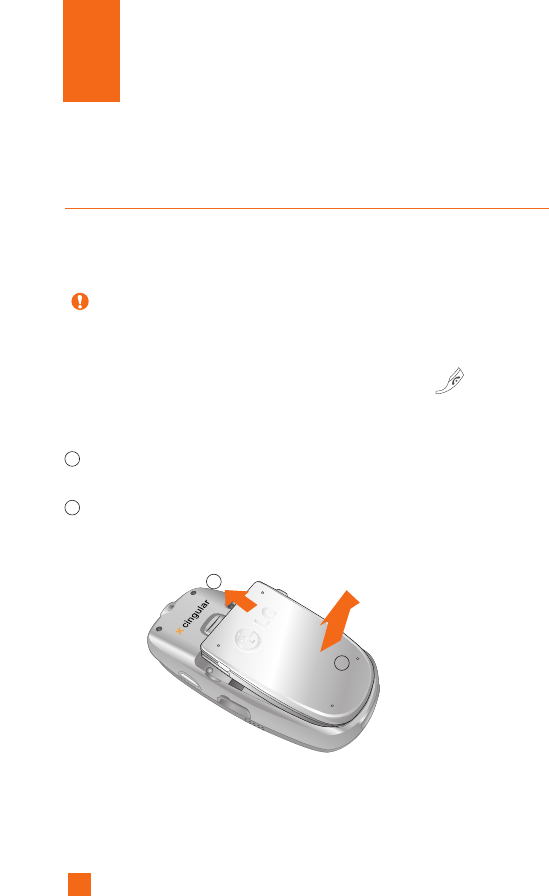
18
Installing the SIM Card
When you subscribe to a cellular network, you are provided with a plug-in
SIM card loaded with your subscription details, such as your PIN, any
optional services available and many others.
1. If necessary, switch off the phone by holding down the key until
the power-off image displays.
2. Remove the battery. To do so:
1 Pull and hold the battery lock above the battery toward the top of the
phone.
2 Lift the battery away, as shown.
Getting Started
Important! The plug-in SIM card and its contacts can be easily damaged
by scratches or bending, so be careful when handling, inserting
or removing the card. Keep all SIM cards out of the reach of
small children.
1
2
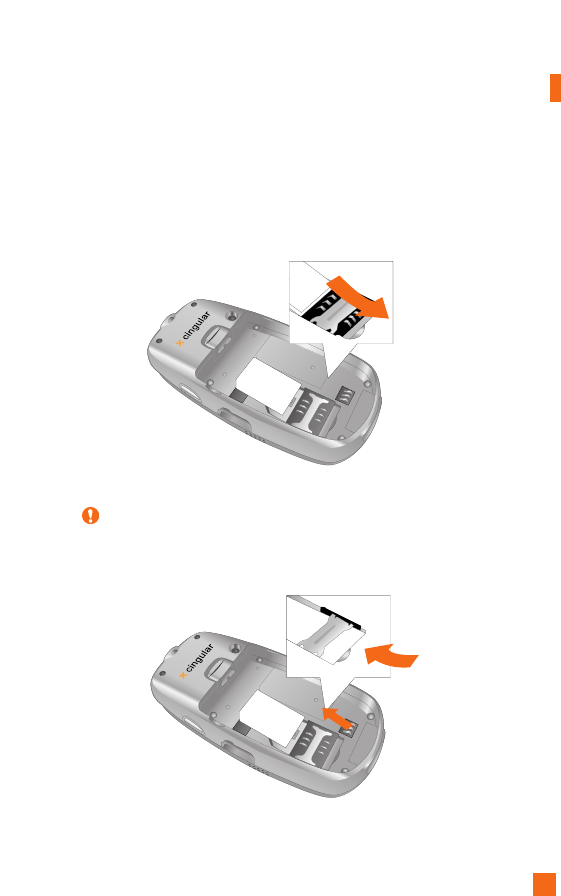
19
Getting Started
Note When you need to remove the SIM card, slide it, as shown, and take it
out of the socket.
3. Slide the SIM card into the SIM card socket so that it locks the card into
place. Make sure that the notched corner is bottom left and the gold
contacts of the card face into the phone.
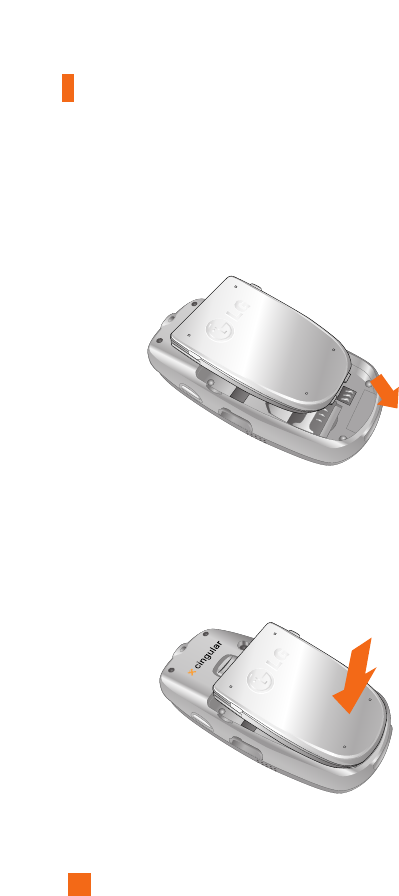
20
Getting Started
5. Press the battery until it clicks into place. Make sure that the battery is
properly installed before switching the phone on.
4. Place the battery so that the tabs on the end align with the slots at the
bottom of the phone.
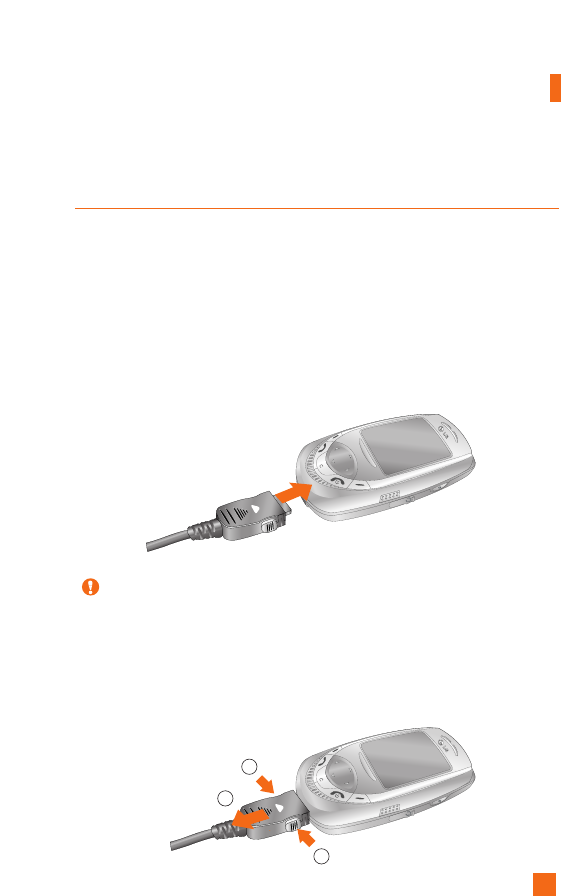
21
Getting Started
3. When charging is finished, disconnect the adapter from the power outlet
and from the phone by pressing on the gray tabs on both sides of the
connector while pulling the connector out.
Charging the Battery
Use of unauthorized accessories could damage your phone and invalidate
your warranty.
To use the travel adapter provided with your phone:
1. With the battery in position on the phone, connect the lead from the
travel adapter to the bottom of the phone. Check that the arrow on the
lead connector is facing towards the front of the phone.
2. Connect the adapter to a standard AC wall outlet. Only use the travel
adapter that comes included with the package.
Warning You must unplug the adapter before we remove the battery from
the phone during charging; otherwise, the phone could be
damaged.
1
1
2

22
Getting Started
Notice
]
If your phone is powered on while charging, you’ll see the bars in the
battery indicator icon cycle.
When the battery is fully charged, the bars in the battery indicator icon will
flash on and off
]
If your phone is powered off, the display will show the charging status.
‘Charging’ or ‘Full’ will be displayed.
If the battery fails to charge completely:
]
After turning the phone on and off, please attempt to recharge the battery.
]
After detaching and reattaching the battery, please attempt to recharge the
battery.
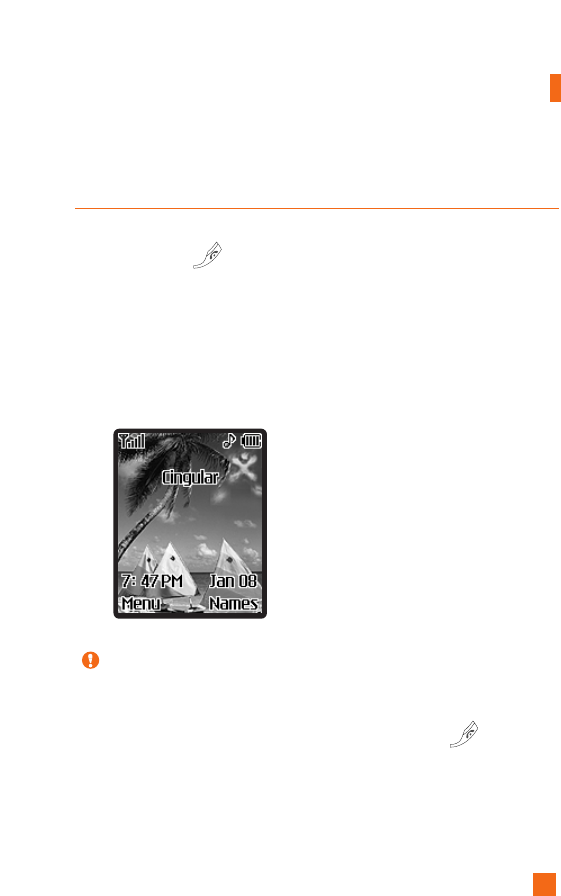
23
Getting Started
Turning Your Phone On and Off
1. Slide the keypad down.
2. Hold down the key until the phone switches on.
3. If the phone asks for a PIN, enter the PIN and press the left soft key
[OK]. For further details, see page 104.
The phone searches for your network and after finding it, the idle screen,
illustrated below, appears on both displays. Now, you can make or
receive a call.
4. When you wish to switch the phone off, hold down the key until
the power-off image displays.
Note The display language is preset to English at the factory. To change the
language, use the Languages menu option (Menu 9.2.3).
For further details, see page 97.

24
Access Codes
You can use the access codes described in this section to avoid
unauthorized use of your phone. The access codes can be changed by using
the Change Codes feature (Menu 9.5.3).
Security code (4 to 8 digits)
The security code protects the unauthorized use of your phone. The default
security code is set to ‘0000’ and the security code is required to delete all
phone entries and to activate the Restore Factory Settings menu. The
security code default setting can be modified from the Security Settings
menu.
Barring Password
The barring password is required when you use the Call Barring function.
The password is obtained from the service provider when you subscribe to
this function. See page 104 for further details.
Getting Started

25
General Functions
Making a Call
1. Make sure your phone is powered on.
2. Enter a phone number including the area code. To edit a number on the
display screen, press the right/left navigation keys to move the cursor to
desired position or simply press the key to erase one digit at a
time.
]
Press and hold the key to erase the entire number.
3. Press the key to call the number.
4. When finished, press the key.
Making a Call by Send Key
1. Press the key, and the most recent incoming, outgoing and missed
phone numbers will be displayed.
2. Select the desired number by using the navigation key.
3. Press the key.
Making International Calls
1. Press and hold the key for the international prefix.
The ‘+’ character can be replaced with the international access code.
2. Enter the country code, area code, and the phone number.
3. Press the key.
Ending a Call
When you have finished a call, press the key.

26
Making a Call From the Contact List
You can store names and phone numbers dialed frequently in the SIM card
as well as the phone memory known as the Contact List.
You can dial a number by simply looking up a name in the contact list. For
more details on the Contact List feature, please refer to page 89.
Adjusting the Volume
During a call, if you want to adjust the earpiece volume, use the side keys
of the phone.
In idle mode, you can adjust the ring volume using the side keys.
Answering a Call
When you receive a call, the phone rings and the flashing phone icon
appears on the screen. If the caller can be identified, the caller’s phone
number(or name if stored in your Address Book) is displayed.
1. Open the Slide and press the key or the left soft key to answer an
incoming call. If Any Key has been set as the answer mode (Menu
9.4.2), any key press will answer a call except for the key or the
right soft key.
nNotice
]
To reject an incoming call, press and hold the side keys on the left side of
the phone.
]
If Slide Open has been set as the answer mode (Menu 9.4.2), you do not
need to press any key. You can answer the call simply by opening the slide.
2. End the call by closing the phone or pressing the key.
nNotice You can answer a call while using the Address Book or other menu
features.
General Functions

27
General Functions
Vibrate Mode (Quick)
Vibrate Mode can be activated by pressing and holding down key.
Signal Strength
If you are inside a building, being near a window may give you better
reception. You can see the strength of your signal by the signal indicator
( ) on your phone’s display screen.
Entering Text
You can enter alphanumeric characters by using the phone’s keypad. For
example, storing names in the Address Book, writing a message, creating
scheduling events in the calendar all require entering text.
The following text input methods are available in the phone.
T9 Mode
This mode allows you to enter words with only one keystroke per letter.
Each key on the keypad has more than one letter. The T9 mode
automatically compares your keystrokes with an internal linguistic
dictionary to determine the correct word, thus requiring far fewer
keystrokes than the traditional ABC mode.
ABC Mode
This mode allows you to enter letters by pressing the key labeled with the
required letter once, twice, three or four times until the letter is displayed.
123 Mode(Numbers Mode)
Type numbers using one keystroke per number. To change to 123 mode in
a text entry field, press key until 123 mode is displayed.

28
Symbolic Mode
This mode allows you to enter special characters.
Changing the Text Input Mode
1. When you are in a field that allows characters to be entered, you will
notice the text input mode indicator in the upper right corner of the
display.
2. If you want to change modes, press and hold down the key. The
available modes are displayed.
Using the T9 Mode
The T9 predictive text input mode allows you to enter words easily with a
minimum number of key presses. As you press each key, the phone begins
to display the characters that it thinks you are typing based on a built-in
dictionary. As new letters are added, the word changes to reflect the most
likely candidate from the dictionary.
1. When you are in the T9 predictive text input mode, start entering a word
by pressing keys to Press one key per letter.
]
The word changes as letters are typed - ignore what’s on the screen
until the word is typed completely.
]
If the word is still incorrect after typing completely, press the down
navigation key once or more to cycle through the other word options.
Example: Press to type Good
Press [down navigation key] to type
Home
]
If the desired word is missing from the word choices list, add it by
using the ABC mode.
2. Enter the whole word before editing or deleting any keystrokes.
Notice You can select a different T9 language from the menu option. The
default setting on the phone is T9 disabled mode.
General Functions

29
General Functions
3. Complete each word with a space by pressing the key.
To delete letters, press . Press and hold down to erase entire
words.
Using the ABC Mode
Use the to keys to enter your text.
1. Press the key labeled with the required letter:
]
Once for the first letter
]
Twice for the second letter
]
And so on
2. To insert a space, press the key once. To delete letters, press the
key. Press and hold down the key to clear the display.
Notice To exit the text input mode without saving your input,
press . The phone returns to the previous menu level.
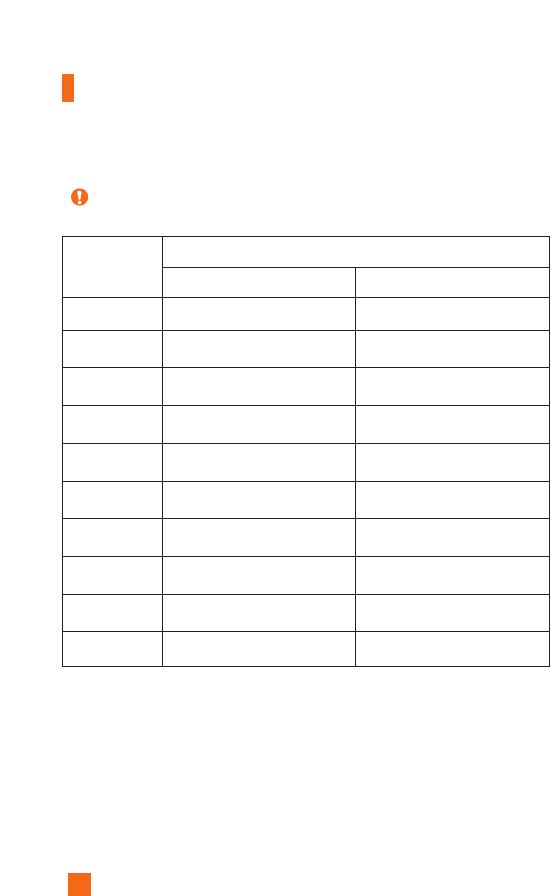
30
Characters in the Order Display
Upper Case Lower Case
. , - ¿ ? ¡ ! @ 1 . , - ¿ ? ¡ ! @ 1
A B C Á Ã Ç 2 a b c á ã ç 2
D E F É 3 d e f é 3
G H I Í 4 g h i í 4
J K L 5 j k l 5
M N O Ó Ñ 6 m n o ó ñ 6
P Q R S 7 p q r s 7
T U V Ú Ü 8 t u v ú ü 8
W X Y Z 9 w x y z 9
Space Key Space Key
Notice Refer to the table below for more information on the characters
available using the keys.
Using the 123 (Numbers) Mode
The 123 Mode enables you to enter numbers in a text message
(a telephone number, for example).
Press the keys corresponding to the required digits before manually
switching back to the appropriate text entry mode.
1
2
3
4
5
6
7
8
9
0
Key
General Functions

31
General Functions
Using the Symbol Mode
The Symbol Mode enables you to enter various symbols or special
characters.
To enter a symbol, press the key. Use the navigation keys to select the
desired symbol and press the [OK] key.
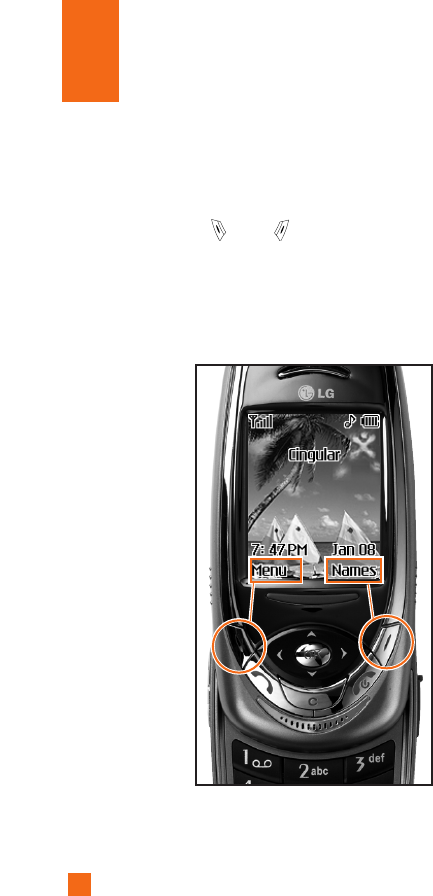
32
Your phone offers a set of functions that allow you to customize the phone.
These functions are arranged in menus and sub-menus, accessed via the
two soft keys marked and . Each menu and sub-menu allows
you to view and alter the settings of a particular function.
The roles of the soft keys vary according to the current context; the label
on the bottom line of the display just above each key indicates its current
role.
Press the left soft key to
access the available
Menu.
Press the right soft key
to access the available
Names.
Selecting Functions and Options

33
You can store phone numbers and their corresponding names in the
memory of your SIM card.
In addition, you can store up to 255 numbers and names in the phone
memory.
The SIM card and phone memory, although physically separate, are
utilized like a single entity known as the Contact List. (See page 89 for
details)
Address Book

34
Your phone provides a number of control functions that you can use during
a call. To access these functions during a call, press the left soft key
[Options].
During a Call
The menu displayed on the handset screen during a call is different than
the default main menu displayed when in idle screen, and the options are
described below.
Making a Second Call
You can get a number you wish to dial from the Address Book to make a
second call. Press the left soft key then select Contact List.
Swapping Between Two Calls
To switch between two calls, press the left soft key or key, and then
select Swap.
Answering an Incoming Call
To answer an incoming call when the handset is ringing, simply press the
key. The handset is also able to warn you of an incoming call while
you are already on a call. A tone sounds in the earpiece, and the display
will show that a second call is waiting. This feature, known as Call
Waiting, is only available if your network supports it. For details of how
to activate and deactivate it see Call Waiting (Menu 9.4.4).
If Call Waiting is on, you can put the first call on hold and answer the
second, by pressing . You can end the current call and answer the
waiting call by pressing the left soft key and then selecting Active call
menu of End call.
In-Call Menu

35
Rejecting an Incoming Call
You can reject an incoming call without answering by simply pressing
the key.
During a call, you can reject an incoming call by pressing the left soft key,
which is the [Menu] key and selecting the Reject call or by pressing
the key.
Muting the Microphone
You can mute the microphone during a call by pressing the [Menu] key
then selecting Mute or right soft key [Mute]. The handset can be unmuted
by pressing the Unmute menu or right soft key [Unmute]. When the
handset is muted, the caller cannot hear you, but you can still hear them.
Multiparty or Conference Calls
The multiparty or conference service provides you with the ability to have
a simultaneous conversation with more than one caller, if your network
service provider supports this feature. A multiparty call can only be set up
when you have one active call and one call on hold, both calls having been
answered. Once a multiparty call is set up, calls may be added,
disconnected or separated (that is, removed from the multiparty call but
still connected to you) by the person who set up the multiparty call. These
options are all available from the In-Call menu. The maximum callers in a
multiparty call are five. Once started, you are in control of the multiparty
call, and only you can add calls to the multiparty call.
Making a Second Call
You can make a second call while currently on a call. Enter the second
number and press the . When the second call is connected, the first
call is automatically placed on hold. You can swap between calls, by
pressing the key.
In-Call Menu

36
In-Call Menu
Setting Up a Conference Call
To set up a conference call, place one call on hold and while the active call
is on, press the left soft key and then select the Join menu of Conference
call.
Activate the Conference Call on Hold
To activate a conference call on hold, press the left soft key, and then press
the key.
Adding Calls to the Conference Call
To add a call to an existing conference call, press the left soft key, and then
select the Join menu of Conference call.
Private Call in a Conference Call
To have a private call with one caller from a conference call, display the
number of the caller you wish to talk to on the screen, then press the left
soft key. Select the Private menu of Conference call to put all the other
callers on hold.
Ending a Conference Call
Currently displayed caller from a conference call can be disconnected by
pressing the key.

37
The following illustration shows the available menu structure and indicates
the:
]
Number assigned to each menu option.
]
Page where you can find the feature description.
1. Recent Calls (see page 40)
1.1 Missed Calls
1.2 Dialed Calls
1.3 Received Calls
1.4 Delete Recent Calls
1.5 Call Durations
1.5.1 Last Call
1.5.2 Received Calls
1.5.3 Dialed Calls
1.5.4 All Calls
1.6 Data Information
1.6.1 WAP Information
1.6.2 External Device
1.6.3 Total Data
2. Messaging (see page 43)
2.1 Text Messages
2.1.1 Write Message
2.1.2 Inbox
2.1.3 Outbox
2.1.4 Drafts
2.1.5 Settings
2.1.6 Delete All
2.2 Instant Messaging
2.2.1 Sign On
2.2.2 Saved Conversations
2.2.3 Settings
2.2.4 IM Provider
2.3 Multimedia Messages
2.3.1 Write Message
2.3.2 Inbox
2.3.3 Outbox
2.3.4 Drafts
2.3.5 Settings
2.4 Voice Mail
2.4.1 Listen To Voice Mail
2.4.2 Voice Mailbox Number
2.5 Download Messages
2.5.1 Inbox
2.5.2 Receive
Menu Tree

38
2. Messaging (continued)
2.6 Templates
2.6.1 Text
2.6.2 Multimedia
2.6.3 Business Card
2.7 Memory Status
3. Games & Apps (see page 63)
3.1 Shop Games
3.2 Games & Apps
3.3 Bookmarks
3.4 View Information
3.4.1 Memory Status
3.4.2 Java Version
4. MEdia Net (see page 66)
4.1 MEdia Home
4.2 Bookmarks
4.3 Go To URL
4.4 Access Point
4.5 Cache Settings
4.5.1 Clear Cache
4.5.2 Cache Check
4.6 Security Certificates
4.7 WAP Information
5. MEdia Mall (see page 71)
5.1 Shop Ringtones
5.2 Shop Games
5.3 Shop Graphics
5.4 Shop MMS
5.5 Shop Applications
5.6 MEdia Home
6. PTT (see page 72)
7. My MEdia (see page 85)
7.1 Bookmarks
7.2 Games & Apps
7.3 Ringtone/Audio
7.4 Graphics
7.5 Multimedia Contents
7.6 Tools
7.6.1 Alarm Clock
7.6.2 Calendar
7.6.3 Voice Recording
7.6.4 Calculator
7.6.5 Memo
7.6.6 World Time
7.6.7 Unit Converter
8. Address Book (see page 93)
8.1 Contact List
8.2 New Contact
8.3 Speed Dials
8.4 Voice Tag List
8.5 Caller Groups
8.6 Copy All
8.7 Delete All
8.8 Set memory
8.9 Information
Menu Tree

39
9. Settings (see page 99)
9.1 Sounds
9.1.1 Shop Ringtones
9.1.2 Ringtones
9.1.3 Volume
9.1.4 Message Alert Tones
9.1.5 Key Tones
9.1.6 Voice Recording
9.2 Display
9.2.1 My Wallpaper
9.2.2 Backlight
9.2.3 Languages
9.2.4 Menu Style
9.3 Date & Time
9.3.1 Set Date
9.3.2 Date Format
9.3.3 Set Time
9.3.4 Time Format
9.3.5 Auto Update
9.4 Call Settings
9.4.1 Call Forwarding
9.4.2 Answer Mode
9.4.3 Send My Number
9.4.4 Call Waiting
9.4.5 Minute Minder
9.4.6 Voice Dial
9.4.7 Auto Redial
9.4.8 Closed User Group
9.4.9 TTY
9.4.0 Send DTMF
9. Settings (continued)
9.5 Security
9.5.1 PIN Code Request
9.5.2 Fixed Dial Number
9.5.3 Change Codes
9.6 Connection
9.6.1 World Phone
9.6.2 GPRS Attach
9.6.3 Access Point
9.6.4 Reset Access Point
9.7 Reset Setting
*
Menu Tree

40
Recent Calls
You can check the record of missed, received, and dialed calls only if the
network supports the Calling Line Identification (CLI) within the service
area.
The number and name (if available) are displayed together with the date
and time at which the call was made. You can also view call times.
Missed Calls Menu 1.1
This option lets you view the last 10 unanswered calls. You can also:
• View the number if available and call it, or save it in the Address Book
• Enter a new name for the number and save both in the Address Book
• Send a message by this number
• Delete the call from the list
Dialed Calls Menu 1.2
This option lets you view the last 20 outgoing calls(called or attempted).
You can also:
• View the number if available and call it or save it in the Address Book
• Enter new name for the number and save both in the Address Book
• Send a message by this number
• Delete the call from the list
Received Calls Menu 1.3
This option lets you view the last 20 incoming calls. You can also:
• View the number if available and call it, or save it in the Address Book
• Enter a new name for the number and save both in the Address Book
• Send a message by this number
• Delete the call from the list

41
Delete Recent Calls Menu 1.4
Allows you to delete Missed, Received and Dialed call lists. You can
delete all call lists at one time.
Call Durations Menu 1.5
Allows you to view the duration of your incoming and outgoing calls. You
can also reset the call times. The following timers are available:
Last Call (Menu 1.5.1)
Length of the last call.
Received Calls (Menu 1.5.2)
Length of the incoming calls.
Dialed Calls (Menu 1.5.3)
Length of the outgoing calls.
All Calls (Menu 1.5.4)
Total length of all calls made and incoming calls since the timer was last
reset.
Recent Calls
Notice The actual time invoiced for calls by your service provider may vary,
depending upon network features, rounding-off for billing, and so
forth.

42
Data Information Menu 1.8
You can check the amount of data transferred over the network through the
GPRS information option. In addition, you can also view how much time
you are online.
WAP Information (Menu 1.8.1)
You can check the data volume and the duration through WAP.
External Device (Menu 1.8.2)
You can check the data volume and the duration through GPRS by using
an external device such as a serial port.
Total Data (Menu 1.8.3)
You can check the total amount of data through WAP and an external
device.
Recent Calls
Notice GPRS General Packet Radio Service

43
Text Messages Menu 2.1
Your phone receives voice mail notification messages and Short Message
Service (SMS) messages.
Voice mail and SMS are network services. Please contact your service
provider for more information.
When the icon appears, you have received a new voice mail. When
the icon appears, you have received a new text message. If the
message memory is full, an error message is displayed, the icon
flashes and you cannot receive any new messages. Use the Delete option in
the Inbox (Menu 2.1.2) to delete obsolete messages. Once there is space in
the memory any undelivered SMS messages will be received (provided
sufficient space is available).
Write Message (Menu 2.1.1)
You can write and edit text messages of up to 918 characters.
1. Type in a message using key presses. For details on how to enter text,
refer to page 27 (Entering Text).
2. After completing the message select the required option by pressing the
left soft key [Options].
The following options are available.
]
Send To Number: Enter the phone number or select the number from
the address book.
]
Send To Email: Enter the email or select the email from the address
book.
]
Save To Drafts: Save the message so that it can be sent later.
]
T9 Languages: Choose between English or Spanish T9 language. For
details on how to enter text, refer to page 28 (Using the T9 Mode).
]
Clear Text: Deletes the written message.
]
Exit Editor: Exit the text editor.
*
*:Shown only if supported by SIM card
Messaging

44
The following options are available. (Press the right soft key [Attach])
]
Symbol: Attach special characters.
]
Picture: Send and receive text messages that contain pictures, known as
Enhanced Messaging Service. Several preset pictures are available in the
phone and they can be replaced with new ones received from other
sources.
]
Animation: Attaching an animation in a message can be
done through EMS(Enhanced Messaging Service).
]
Sound: Attach sounds that are available for short message.
]
Text Templates: Use the text templates already set in the phone.
]
Phone Number: Attach a phone number.
]
Business Card: Attach your name card.
Inbox (Menu 2.1.2)
Received text messages, page messages, and email lists may be searched
and the contents may be viewed. Received messages are displayed from
newest to oldest.
The following options are available.
]
Reply: Replies to the received message.
]
Delete: Deletes the selected message from the Inbox.
]
Forward: Forwards a received message to other recipients. After
recipients are entered, the message can be forwarded.
]
Return Call: Call back the sender.
]
Extract: Extract picture, sound, text webpage and email address from
the message.
Messaging

45
Messaging
Outbox (Menu 2.1.3)
View lists and contents of sent messages in this menu and also verify if
transmission was successful.
The following options are available.
]
Delete: Deletes the selected message from the Outbox.
]
Forward: Forwards the current message to other recipients.
Drafts (Menu 2.1.4)
This menu option shows the preset message list. Scroll through the list
using the up/down navigation keys.
The following options are available.
]
Edit: You can edit a selected message.
]
Delete: Deletes the selected preset message.
Settings (Menu 2.1.5)
This menu allows you to set up default SMS information.
]
Message Types: Allows you to set the default message type (Text,
Voice, Fax, Paging, X.400, E-mail, ERMES). The network can convert
the messages into the selected format. The type of message you desire
can be set to Text Type.
]
Valid Period: Allows you to set the length of time for which your text
messages will be stored at the SMS center while attempts are made to
deliver them to the recipient. Possible values are Maximum, 30 Minutes,
1 Hour, 6 Hours, 1 Day and 1 Week which can be authorized by your
service provider.
*
**
*
*:Shown only if supported by SIM card

46
]
Delivery Reports: Allows you to activate or deactivate the report
function. When this function is activated, the network informs you
whether or not your message has been delivered.
]
Reply With Same Service: Allows the recipient of your SMS message
to send you a reply via your message center, if the service is provided by
the network.
]
Message Center Number: Allows you to store or change the number of
your email gateway required when sending text messages. You must
obtain this number from your service provider.
]
Email Gateway: Allows you to store or change the number of your
email gateway required when sending text messages.
]
Subject: If you set it to on, allows you to enter the subject.
]
Bearer Setting: You can select GPRS or GSM. Contact your network
operator or service provider for information related to setting a selected
bearer, pricing and connection speed.
GSM Preferred/GPRS Preferred
Delete All (Menu 2.1.6)
Allows you to delete all messages.
*
*
*:Shown only if supported by SIM card
Messaging

47
Messaging
Instant Messaging Menu 2.2
Instant Message feature can only be used with the support of the network
operator or the community. For Instant Message users a valid user
ID(Screen name) will be required in order to Login(Sign On/Connect) and
exchange messages as well as check the online status.
There are three ways to use the Instant Message feature.
1. Through the Main Menu.
2. Through the Message box Menu(Pressing and holding the right
navigation key).
3. Through the IM hotkey (the left navigation key). Short pressing the
hotkey will bring up the Login screen and long pressing the hotkey will
automatically begin the login process for the IM community selected
previously.
The menu items below might not appear since not all IM communities
support the various options. Also the menu strings may appear differently
based on the selected IM communities.
Offline Menu
Login(Sign On/Connect) (Menu 2.2.1)
This allows users to Login by filling in the User ID (Screen Name) and
Password.
Saved Conversations (Menu 2.2.2)
This is where a user can view saved conversation.

48
Messaging
Settings (Menu 2.2.3)
]
Screen Name: You may select the Screen Name to be used while in the
Group chat service.
]
Availability: You may select your availability status to Not Available
(Away / Do Not Disturb).
]
Mood: You may select your current mood as in Happy, Sad, Angry,
Jealous, In Love, Sleep, etc.
]
Status Text: You may set your current status in free text format.
IM Provider (Menu 2.2.4)
This menu option offers the ability to store your login information such as
the User ID and Password.
]
Activate: You may select the default Community.
]
Settings
* User ID (Screen Name): You can store the User ID(Screen name).
* Password: You can store the Password.
* Binding Protocol: You can select the Bearer type.
* SMS GW Number: You can change the SMS gateway number.
]
Rename: You can change the Community name.
]
Delete: You can delete the Community information
]
Delete All: You can delete all information related to the Community, but
Default Community settings are preserved.
]
Add New Provider: You can add a new Community.
Note When changing or adding a new Community, please check with your
Network provider.
Note When changing or adding a new Community, please check with your
Network provider.

49
Messaging
Online Menu / 1 to 1 conversation
After successful Login (Sign On / Connect), a contactlist with
contacts(buddies) will appear on screen. Depending on the cursor location
in the contactlist(buddylist), following menu options will be available.
When cursor is located on the Unknown List (Strangers)
View/Hide Contacts (View/Hide Buddies): This provides the option to
view or hide contacts (buddies) from the selected list.
Chat (Send IM / Send Message): This offers the ability send a message to
unknown contact(stranger). When selected, User ID (Screen Name) must
be typed in prior to starting an IM session or conversation.
]
Settings
• Screen Name: You may select the Screen Name to be used while in the
Group chat service.
• Availability: You may select your availability status to Not Available
(Away / Do Not Disturb).
• Mood: You may select your current mood as in Happy, Sad, Angry,
Jealous, In Love, Sleep, etc.
• Status Text: You may set your current status in free text format.
• Watcher List: You may view contacts(buddies) who can access your
presence information.
• View Options: You may allow only contacts(buddies) online from your
contactlist(buddylist) or everyone to view.
]
Saved Conversations: You may view or delete the stored conversation
session.
]
Logout (Sign Off / Disconnect): This begins the Logout (Sign Off /
Disconnect) process.

50
Messaging
When cursor is located on the Unknown Contact (Stranger)
]
Chat(Send IM/Send Message)/View: This will allow you to converse
with the selected Unknown Contact (Stranger).
]
Block/Unblock Contact (Block/Unblock Buddy): This allows or blocks
conversation with the selected Unknown Contact (Stranger).
]
Add To List: This allows you to add the Unknown Contact (Stranger) to
the Contact (Buddy) list. After the selecting the contactlist (buddylist),
you may add the Unknown Contact (Stranger) and once completed it is
automatically deleted from the Unknown List (Strangers).
]
End Conversation: Selected Unknown Contact (Stranger) is deleted and
the conversation is ended.
]
Settings: Please refer to the Settings Menu on page 49.
]
Saved Conversations: You may view or delete the stored conversation
session.
]
Logout (Sign Off/Disconnect): This begins the Logout (Sign Off /
Disconnect) process.
When cursor is located on the Contactlist (Buddylist)
]
View/Hide Contacts (View/Hide Buddies): This allows the selected
contacts (buddies) in the list to be viewed or hidden.
]
Refresh List: This refreshes the presence information of the contacts
(buddies) within the contactlist (Buddylist).
]
Rename List: This renames the selected contactlist(buddylist).
]
Add List: This adds a new contactlist(buddylist).
]
Add Contact: This adds the selected contact (buddy) to the
contactlist(buddylist), or searches in the Community.
]
Delete List: This deletes the selected contactlist(buddylist).
]
Settings: Please refer to the Settings Menu on page 52.

51
Messaging
]
Saved Conversations: You may view or delete the stored conversation
session.
]
Logout (Sign Off/Disconnect): This begins the Logout (Sign Off /
Disconnect) process.
When cursor is located on the Contact (Buddy)
]
Chat(Send IM/Send Message)/View: This will display a screen where
conversation with selected Contact (Buddy) can take place.
]
Rename Contact(Rename Buddy): Selected Contact (Buddy) name can
be changed or renamed.
]
Block / Unblock Contact (Block / Unblock Buddy): This allows or
blocks conversation with the selected Contact (Buddy).
]
Subscribe To: This sets the automatic update of presence information for
a selected Contact (Buddy).
]
Unsubscribe To: This cancels the automatic update presence setting for a
selected Contact (Buddy).
]
Delete Contact (Delete Buddy): This deletes the selected Contact
(Buddy).
]
View Information: This allows for viewing of the selected Contact
(Buddy) information.
]
Settings: Please refer to the Settings Menu on page 49.
]
Saved Conversations: You may view or delete the stored conversation
session.
]
Logout (Sign Off/Disconnect): This begins the Logout (Sign Off /
Disconnect) process.

52
Messaging
Menu options available in the Conversation screen
]
Send: Typed message can be sent.
]
Back To List: This brings the screen back to the contact (buddy) list.
]
End Conversation: This ends the active conversation and clears the
conversation buffer.
]
Block / Unblock Contact (Block / Unblock Buddy): This allows or blocks
conversation with the selected Unknown Contact (Stranger).
]
Save Conversation: Stores currently active conversation.
]
View Information: Selected Contact (Buddy) information can be viewed.
]
T9 Languages: This selects the T9 predictive mode Language.
* Within the conversation screen, you can insert a template using the right
soft key.
Online Menu / Group chat
When cursor is located on the Group List
]
View/Hide Groups: You can choose to view or hide the Group Chat List.
]
Join New Group: This allows you to join a new Group Chat. In order to
join, Group ID is required.
]
Search Group: You can join after searching the Group chat.
]
Make Group: A new group chat can be created after typing in the group
ID and the welcome note.
]
Settings: Please refer to the Settings Menu on page 49.
]
Saved Conversations: You may view or delete the stored conversation
session.
]
Logout (Sign Off/Disconnect): This begins the Logout (Sign Off /
Disconnect) process.

53
Messaging
Menu options available in the group chat screen
(Only if it’s been created by yourself.)
]
Send: This sends the typed message to all active members within the
Group Chat.
]
Invite Others: This allows you to invite other contact (buddy) to the
group chat. You can use the contact (buddy) list within the menu or by
inviting based on the search results.
]
Back To List: This brings the screen back to the contact (buddy) list.
]
Leave Group: When leaving the active group chat session, the buffer is
cleared.
]
Save Conversation: Stored conversation can be viewed or deleted.
]
Delete Group: This deletes the entire active group chat, only if it's been
created by yourself.
]
Show Members (People here/Now chatting): This displays current
members who have joined the active group chat session.
]
T9 Languages: This selects the T9 predictive mode Language.

54
Messaging
Multimedia Messages Menu 2.3
A multimedia message can contain text, images, and/or sound clips. This
feature can be used only if it is supported by your network operator or
service provider. Only devices that offer compatible multimedia message
or e-mail features can receive and multimedia messages. Attach to add
Symbol, Picture, Sound, Recorded Voice, Text Template.
Write Message (Menu 2.3.1)
The following options are available.
• Send: Support mutiple number and email addresses.
• Preview: To see the multimedia message you wrote.
• Save: Allows you to save multimedia messages in draft or as templates.
• Delete: Deletes the MMS message.
• Slide Duration: Allows you to set timer for slide and text.
• Slide Format: Allows you to make the message contents aligned right,
left, top and bottom.
• Add Slide: Allows you to add a slide before or after current slide.
• Remove Slide: Deletes the selected slide.
• Add Image: Allows you to add a image before or after current image.
• Add Sound: Allows you to add a sound before or after current sound.
• Delete Image: Deletes the current image.
• Delete Sound: Deletes the current sound.

55
Messaging
Inbox (Menu 2.3.2)
You will be alerted when you have received messages. They will be stored
in the Inbox. In the Inbox, you can identify each message by icons. For
detail, see the icon directive below.
If the phone has ‘no space for message’, you can make space in each
repository by deleting messages, media and applications.
• Timer Stop: Timer stop menu is displayed when you receive the
message including various pictures. Usually, the pictures slide
automatically. However, if you select this menu, you can see the next
picture by pressing the left soft key manually.
• Previous Slide: View the previous page.
• Restart: Allows you to replay multimedia messages.
• Save Message: Allows you to save a multimedia message in draft or as
template.
• Save Items: Allows you to extract picture and sound.
• Details: Allows you, to view information about received messages;
Sender’s address, Subject (only for multimedia message), Message date
& time, Message type, Message size.
• Reply: Allows you to reply to the sender.
• Reply All: Allows you to reply to the senders.
• Delete Message: Allows you to delete the current message.
• Forward: Allows you to forward the selected message to other
recipients.

56
Messaging
Outbox (Menu 2.3.3)
Allows you to see sent messages here. For sent message, you can see the
delivery status.
• Timer Stop: Timer stop menu is displayed when you receive the
message including various pictures. Usually, the pictures slide
automatically. However, if you select this menu, you can see the next
picture by pressing the left soft key manually.
• Previous Slide: View the previous page.
• Restart: Allows you to replay current messages.
• Save Message: Allows you to save multimedia message in draft or as
template.
• Save Items: Save the item such as image or sound as an attachment in a
message.
• Details: Allows you to view information about outbox messages; Subject
(only for multimedia message), Message date & time, Message type,
Message size.
• Reply: Allows you to reply to the current message.
• Reply All: Allows you to reply to the all messages.
• Delete Message: Allows you to delete the current message.
• Forward: Allows you to forward the current message to other recipients.

57
Messaging
Drafts (Menu 2.3.4)
Using this menu, you can preset up to five multimedia messages that you
use most frequently. This menu shows the preset multimedia message list.
The following options are available.
• Send: Support mutiple number and email addresses.
• Preview: To see the multimedia message you wrote.
• Save: Allows you to save multimedia messages in draft or as templates.
• Delete: Allows you to delete the image or sound.
• Slide Duration: Allows you to set timer for slide and text.
• Slide Format: Allows you to make the message contents aligned right,
left, top and bottom.
• Add Slide: Allows you to add a slide before or after current slide.
• Remove Slide: Allows you to move to previous or next slide.
• Add Image: Allows you to add a image before or after current image.
• Add Sound: Allows you to add a sound before or after current sound.
• Delete Image: Deletes the current image.
• Delete Sound: Deletes the current sound.

58
Messaging
Settings (Menu 2.3.5)
Via this menu, you can set up default multimedia message information.
The following options are available:
]
Message Subject: Enter the message title.
]
Slide Duration: Display the duration of each page when writing the
message.
]
Alignment: Set the position of a message and text message.
• Image Bottom • Image Left
• Image Top • Image Right
]
Valid Period: Set the duration for keeping messages on the network
server.
]
Auto Download
• On: If you select this, messages are downloaded automatically on
receipt.
• Confirm: Requires you to confirm you want to download the message.
• Off: Defers downloading messages.
]
Message Center URL: Enter the address of an MMS server to use the
MMS service.
]
Access Point: For further details, see page 69.

59
Messaging
Voice Mail Menu 2.4
This menu provides you with a quick way of accessing your voice mailbox
(if provided by your network).
Before using this feature, you must enter the voice server number obtained
from your service provider.
When new voicemail is received, the symbol will be displayed on the
screen. Please check with your network service provider for details of their
service in order to configure the handset accordingly.
Listen To Voice Mail (Menu 2.4.1)
Before using this feature, you must enter the voice server number obtained
from your service provider (see menu option 2.4.2). You can then select
this option and press the left soft key [OK] to listen to your messages.
You can quickly connect to the first voice server by pressing and holding
the key in Idle Mode.
Voice Mailbox Number (Menu 2.4.2)
Allows you to change the voice mail server number, if necessary.
Note Voice Mail is a network feature. Please contact your service provider
for further details.

60
Messaging
Download Messages Menu 2.5
Inbox (Menu 2.5.1)
You can order push messages from WAP service providers.
Push messages are notifications of, for example, news headlines and they
may contain a text message or address of a WAP service. For availability
and subscription, contact your WAP service provider.
Service providers can update an existing push message every time a new
push message is received. Messages can be updated even if you have
moved them to another folder. Push messages expire and they are deleted
automatically.
]
Information: Shows the information of received push messages.
]
Load: Allows you to connect to a specific site using the information in
the received push message.
]
Delete: Delete the selected push message.
Receive (Menu 2.5.2)
You can set the option whether you will receive the message or not.

61
Messaging
Templates Menu 2.6
There are 6 predefined messages in the list. You can view and edit the
template messages or create new messages.
Text (Menu 2.6.1)
• Please call me back • I’m late. I will be there at
• Where are you now? • I’m on the way.
• Urgent! Please contact. • I love you
The following options are available.
]
Edit: Allows you to write a new message or edit the selected template
message.
]
Send Via Text Message: Sends the selected template message by SMS.
]
Send Via Multimedia Message: Sends the selected template message
by MMS.
]
Delete: Allows you to delete the selected template message.
Multimedia (Menu 2.6.2)
For further details, see page 54.
• Send: Support mutiple number and email addresses.
• Preview: To see the multimedia message you wrote.
• Save: Allows you to save multimedia messages in draft or as templates.
• Delete: Deletes the MMS message.
• Slide Duration: Allows you to set timer for slide and text.
• Slide Format: Allows you to make the message contents aligned right,
left, top and bottom.
• Add Slide: Allows you to add a slide before or after current slide.
• Remove Slide: Deletes the selected slide.

62
Messaging
• Add Image: Allows you to add a image before or after current image.
• Add Sound: Allows you to add a sound before or after current sound.
• Delete Image: Deletes the current image.
• Delete Sound: Deletes the current sound.
Business Card (Menu 2.6.3)
This option allows you to make your own name card. Key in the Name,
Mobile number, Office number, Fax number and E-mail address.
]
Edit: Allows you to write a new message or edit the selected name card.
]
Send Via Text Message: Sends the selected name card by SMS.
]
Send Via Multimedia Message: Sends the selected name card by
MMS.
]
Delete: Allows you to delete the selected name card.
Memory Status Menu 2.7
You can check the current memory status of each memory for SMS and
MMS.

63
Java is a technology developed by Sun Microsystems. Similar to the way
you would download the Java Applet using the standard Netscape or MS
Internet Explorer browsers, Java MIDIet can be downloaded using the
WAP enabled phone. Depending on the service provider, all Java based
programs such as Java games can be downloaded and run on a phone.
Once downloaded, the Java program can be viewed within the Games &
Apps menu where you can select, execute or delete. The Java program files
saved in the phone are in .JAD and .JAR formats.
Shop Games Menu 3.1
This menu option connects to Cingular’s game download site.
Games & Apps Menu 3.2
Games & Apps menu displays the list of Java programs downloaded using
the WAP. All previous downloaded programs can be selected, deleted or
viewed in detail within the Games & Apps menu. From the list within the
Application menu, the following options are available:
]
Open: Open the selected program. The list includes all Java programs
installed in the phone.
]
Delete: Delete the selected program. Once deleted, you will not be able
to restore the program unless it is downloaded again using the WAP.
Note The JAR file is a compressed format of the Java program and the JAD
file is a description file that includes all detailed information. From the
network, prior to download, you can view all detailed file descriptions
from the JAD file.
Warning Only J2ME (Java 2 Micro Edition) based programs will run in a
phone environment.
The J2SE (Java 2 Standard Edition) based programs will only run
in a PC environment.
Games & Apps

64
]
Details: Display detailed information on the selected program. This
includes the program name, program size, program version, vendor
information and the website address or the URL.
]
Send Information: Selected Java MIDIet information such as MIDIet
name, size, version, vendor and jad URL can be sent via SMS.
Bookmarks Menu 3.3
When a new Java program is downloaded using the WAP, the address
from which a download takes place is known as a bookmark. The Java
menu includes a bookmark list for downloading Java programs and this
bookmark list can be viewed from the Bookmarks menu.
]
Connect: Selected address in the bookmark is used for data connection.
After successful connection, desired Java program can be downloaded
from the list.
]
View: Detailed information on a bookmark can be viewed such as name
of bookmark and address of bookmark.
]
Delete: Selected bookmark is deleted. Deleted bookmark cannot be
restored so caution is required when deleting bookmarks.
]
Edit: Selected bookmark can be edited. Editing a bookmark is done in
the order of URL → Title → Profile(Access Point) → User ID →
Password. When creating a new bookmark, same order is followed. The
service provider can require user ID and password information, but if
none is provided, no input is necessary.
]
Add New: New bookmark is added. If there is no Bookmark, you get a
display indicating that there is no Bookmark. Bookmarks can be added
by pressing the left soft key[Add].
]
Send URL: Selected bookmark URL can be sent via SMS.
]
Delete All: This deletes all of the selected bookmark as well as the
bookmarks directory within the Games & Apps menu.
Games & Apps

65
Games & Apps
View Information Menu 3.4
The downloaded programs using the WAP are stored in the phone
memory. There is a maximum memory capacity in a phone and once you
exceed this memory, you will not be able to store any more programs. The
View Information menu allows you to check the available memory
capacity in a phone.
Memory Status (Menu 3.4.1)
Displays maximum memory capacity and total available memory
information.
Java Version (Menu 3.4.2)
Displays current Java version.
Note After selecting the Connect function to access the Java MIDlet
Provider’s server, you may choose one of many Java programs to
download and install into your phone. Once connected to the server,
the Go button can be pressed to view the JAD information on a desired
program. The Get button will begin the download and install process.
The download and install process will take place simultaneously and
once download is complete you can immediately run the Java program.
The installed Java program can be selected to run at a later time from
the Games & Apps menu.

66
You can access various WAP(Wireless Application Protocol) services such
as banking, news, weather reports, and flight information. These services
are specially designed for mobile phones and they are maintained by the
WAP service providers.
Check the availability of WAP services, pricing and tariffs with your
network operator and/or the service provider whose service you wish to
use. Service providers will also give you instructions on how to use their
services.
Please contact your service provider to open an Internet account. To use
the Web Browser, you must indicate your phone number via the Own
number menu option (See page 94 for further details.)
To launch the browser in standby mode, press and hold down the key.
Once connected, the homepage is displayed. The content depends on the
service provider.
You can open any WWW page by entering its URL address.
To exit the browser at any time, press the key. The idle screen is
displayed.
Navigating with the WAP Browser
You can surf the Internet using either the phone keys or the WAP Browser
menu.
Using the Phone Keys
When surfing the Internet, the phone keys function differently from the
phone mode.
Key Description
up/down navigation key Scroll each line of the content area
MEdia Net

67
MEdia Net
Using the WAP Browser Menu
There are various menu options available when surfing the Wireless Web.
MEdia Home Menu 4.1
Connect to a homepage. The homepage may be the site which is defined in
the activated profile. It will be defined by the Service Provider if you have
not defined it in the activated profile.
Bookmarks Menu 4.2
Your phone may have some pre-installed bookmarks for sites not affiliated
with LG. LG does not warrant or endorse these sites. If you choose to
access them, you should take the same precautions, for security or content,
as you would with any site.
Options in the Bookmarks view
Options available in the Bookmarks are: Connect, View, Edit, Move,
Delete, New Bookmark, New Folder and Send URL
]
Tone Download: Download the ringtone from the selected URL
address.
• Connect: Connect to the URL address to download the ringtone.
• View: View the URL address of the Bookmark.
• Delete: Delete the URL address.
• Edit: Modify the Bookmark.
• Move: Move the Bookmark to other folder.
• New Bookmark: Create new bookmark in current folder.
Note The WAP Browser menus may vary, depending on your version of the
browser.

68
MEdia Net
• New Folder: Create new sub-folder.
• Send URL: Allows the stored URL under Bookmark to be sent via
SMS to another person.
• Delete All: Allows you to erase all bookmarks.
]
Graphic Download: Download the graphic from the selected URL
address.
• Connect: Connect to the URL address to download the graphic.
• View: View the URL address of the Bookmark.
• Delete: Delete the URL address.
• Edit: Modify the Bookmark.
• Move: Move the Bookmark to other folder.
• New Bookmark: Create new bookmark in current folder.
• New Folder: Create new sub-folder.
• Send URL: Allows the stored URL under Bookmark to be sent via
SMS to another person.
• Delete All: Allows you to erase all bookmarks.
Go To URL Menu 4.3
You can directly connect to the site you want. You need to enter a specific
URL.

69
MEdia Net
Access Point Menu 4.4
A Profile is the network information used to connect to the internet.
Cingular supports three kinds of profiles: MEdia Net, Home and Roam.
MEdia Net is used to connect to the internet using GPRS,
Home uses CSD (Circuit Switched Data) with Cingular gateways, and
Roam uses CSD without the Cingular network.
Because Cingular also selects a bearer automatically according to the
current network status, the user doesn’t need to select any of them.
Each profile has submenus as follows:
]
Activate: Set a current profile as a default.
]
Settings: Edit the various items of the current profile.
]
Rename: Revise the name of profile.
]
Add New: Create new profile.
]
Delete: Delete the profile.
]
Delete All: Allows all Profiles within the Access Point to be deleted so
please take precaution prior to using this option.
MEdia Net
1. Activate
2. Settings
3. Rename
4. Add New
5. Delete
6. Delete All
Home
1. Activate
2. Settings
3. Rename
4. Add New
5. Delete
6. Delete All
Roam
1. Activate
2. Settings
3. Rename
4. Add New
5. Delete
6. Delete All
Note The changes using these options may affect the other application
function.
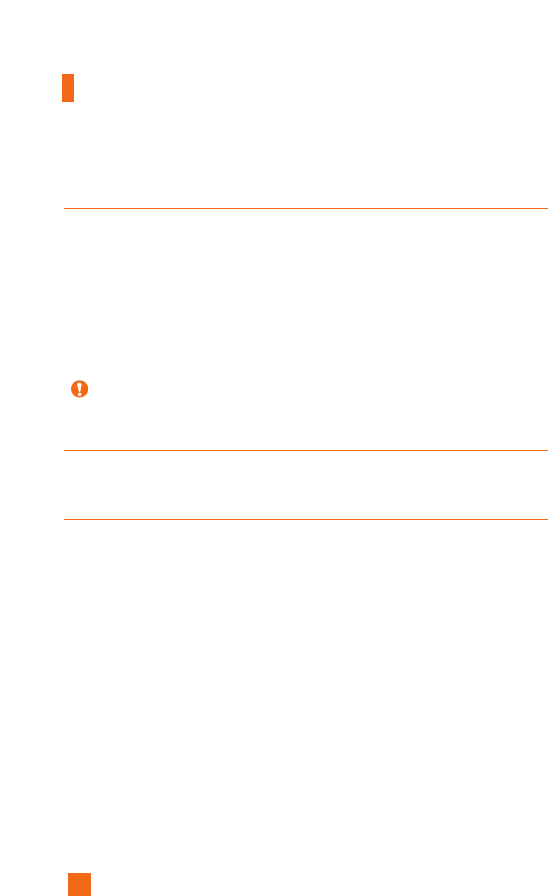
70
MEdia Net
Cache Settings Menu 4.5
The information or services you have accessed are stored in the cache
memory of the phone.
Clear Cache (Menu 4.5.1)
Remove all contexts saved in cache.
Cache Check (Menu 4.5.2)
Set a value whether a connection attempt is made through cache or not.
Security Certificates Menu 4.6
A list of the available certificates is shown.
WAP Information Menu 4.7
The WAP Browser version is displayed.
Note A cache is a buffer memory, which is used to store data temporarily.

71
MEdia Mall
Shop Ringtones Menu 5.1
This menu option connects to Cingular’s ringtone download site.
Shop Games Menu 5.2
This menu option connects to Cingular’s game download site.
Shop Graphics Menu 5.3
This menu option connects to Cingular’s graphic download site
Shop MMS Menu 5.4
This allows you to connect to http://mmsstore.cingular.com URL and
download multimedia contents
Shop Applications Menu 5.5
This menu option connects to Cingular’s application download site
MEdia Home Menu 5.6
Connect to a homepage. The homepage may be the site which is defined in
the activated profile. It will be defined by the Service Provider if you have
not defined it in the activated profile. For further details, see page 66~67.

72
Want to talk? Why not PTT?
PTT lets you speak with your contacts either in groups or as individuals.
So whether it's checking someone’s availability for a quick brainstorm, or
updating your whole team at once, PTT gives you instant access to the
people you need, when you need them.
When you use PTT, you can tell at a glance whether your PTT contacts are
available to talk or not. If they are, you press a single key and begin. No
waiting for an answer. And if they’re not available at that moment, you’ll
be updated as soon as they are.
welcome to PTT
PTT gives you the flexibility to stay in touch with your colleagues in the
way that suits you most.
Once you’ve added a PTT contact, a long press on the PTT key which gets
you in touch with an individual or group so you’ll always be able to update
them immediately.
You then need to contact Cingular Customer Services to activate your
subscription to PTT. When you’ve done this, you’ll be ready to use PTT
for the first time.
PTT tips
PTT is a great way of communicating instantly with the people who are
important to you. Here are a few tips to help you get the most out of it.
]
You can use your phone settings to turn off all ring tones through the
loudspeaker, including PTT tones.
Changing your phone settings will update your presence status.
1. If you set ring volume to zero, silence or vibration mode in the status of
not DND, your presence will be changed to silence.
PTT

73
PTT
2. If you select other profile except silence/vibrate only and the profile’s
ring tone volume is on, your presence will be changed Available.
]
If you’re in a situation where a PTT call might be inappropriate, set your
availability to Do Not Disturb.
]
When you’re in a public place, why not wear the headphones? This way,
no-one else will hear the tones, and you can have your PTT conversation
in private.
]
You should always log out of PTT and turn your phone off before
removing your SIM Card from your phone.
For help with PTT you can read the PTT help file on your phone. Open
PTT and press Options, then select Help. Open the required help topic for
further information.
the first time you use PTT
1. To launch PTT, press AND HOLD the PTT key on the left side of LG
F7200. Alternatively you can open the main menu and access PTT from
there.
2. You’ll be asked to enter your number including the International dialing
code i.e., +44 minus the leading zero.
3. Select Done.
Once you have opened PTT the symbol appear on your screen.
Whenever you turn your phone on, you will log in to PTT automatically.
Once you have successfully logged in, you will receive a welcome
message from Cingular, and the call screen will appear.

74
PTT contactsTM
invite a PTT contact
Before you can make a PTT call you need to invite the person that you
want to call to join your PTT contacts list. This list is separate from your
main phonebook.
When you try to add a colleague or friend to your PTT contacts list, they
are automatically sent an invitation. You cannot add a person to your PTT
contacts list unless they grant permission via the invitation.
When you send an invitation, the other person has 7 days to reply,
otherwise it will be deleted.
If your invitation is accepted, their name will appear in your PTT contacts
list, and your name will appear in theirs - if the invite is accepted you are
paired.
If your invitation is rejected, you will receive a message informing you that
the other user has declined your invitation.
To add a PTT contact:
1. Open the PTT main menu.
2. Scroll to and select Add new.
3. Enter their name and number. Numbers must be saved in international
format, with no spaces, for example +447123456789. Press Save.
4. An invitation is sent to the contact. While you are waiting for a reply,
you will see the pending icon next to their name.
5. If they accept your invitation, their name will appear in your PTT
contacts list alongside their availability.
This way, you can always tell whether they wish to receive a PTT call or
not.
PTT

75
accept an invite to become a PTT contact
To become a PTT contact simply accept the invitation message that is sent
to you by another PTT user.
When you accept an invitation from a PTT contact, their name and number
are automatically added to your PTT contacts list.
edit or delete a PTT contact
You can personalize your contacts by editing their names, whether for fun
or to make them instantly recognizable.
You can also stay in control of your PTT contacts by deleting contacts
when you no longer need to be in touch.
To edit or delete a contact use the Options menu when you're in their
details.
PTT calls
making a PTT call
To make a PTT call:
1. Press and hold the PTT key on the side of your phone.
2. Scroll to and select the contact you wish to call.
3. Press hold the PTT key and speak into the microphone.
how a PTT call works
When you make a PTT call, you get an instant connection to the person
you want to speak with. No waiting while the phone rings and no missed
calls.
During a PTT call, only one person can speak at a time. You can tell
whether it is your turn to speak by listening for the following tones:
PTT

76
]
rising tone
A connection has been made to another person, and you can begin the PTT
conversation.
]
falling tone
The other person has finished speaking, and it is your turn. Press and hold
the PTT key to have your say. Release the PTT key to let the other person
speak.
]
error tone
You’ve tried to speak while someone else is holding down their PTT key.
Wait until you hear the falling tone before speaking.
the PTT key
While speaking, you should press and hold the PTT key. As soon as you
release the PTT key, the other person will hear the falling tone, and will be
able to talk in response to you.
You also press and hold the PTT key to initiate a PTT call.
To make a PTT call open your PTT contacts list and highlight the person
you need to talk to. Press and hold the PTT key.
availability
Being able to change your availability means that you are always in control
of who you talk to and when. If you do not want to be contacted, simply
change your availability to Do Not Disturb . If you want to have a PTT
conversation and only hear the PTT tones through the earpiece, set your
availability to Silent . If you use your speaker switch to change your
availability to silent, this turns your PTT calls into silent calls, but your
presence status remains unaffected.
PTT
Note Customers should not initiate or participate in a PTT call whilst driving.
The current version of our PTT product requires you to press and hold
the button while talking. For this reason we advise against using PTT
while driving, including with a car kit or personal handsfree kit.

77
To change your availability status use the Options menu in the PTT
contacts list.
You will appear as unavailable when your phone is switched off, or if you
are outside the Cingular service area.
Whenever you switch your phone off, then on again, your availability will
return to the same as it was before you switched your phone off.
You can also check the availability of your PTT contacts, as well as your
PTT groups and members.
Available
You are online and available to talk.
Unavailable
You are offline and unavailable to talk.
Do Not Disturb
You cannot be contacted by other PTT users.
Silent
You are available for a PTT conversation and only hear the PTT tones
through the earpiece.
Pending
You have sent an invitation to a contact to be added to your PTT
contacts list, and are waiting for a reply.
Temporarily Unavailable
The contact is temporarily offline. The contact maybe temporarily out
of coverage. Connection is attempted but may not be successful
Group Available
At least one member of the group is online and available to talk.
Group Unavailable
Every group member is offline.
Group Do Not Disturb
None of the members of the group can be contacted.
PTT

78
Group Silent
All the members of the group are available for a PTT conversation
and can only hear the PTT tones through the earpiece.
Group Pending
You have sent an invitation to contacts to join your group and are
waiting for them to reply.
Group Temporarily Unavailable
The group is temporarily offline.
PTT groups
creating a PTT group
PTT groups are a great way to organize your contacts. Groups are made up
of PTT members. When you create a PTT group, you will first need to
enter the PTT members that you want to include in it. There are three ways
to do this:
]
add new members
]
use existing members
]
create members from your main phonebook.
You can use any combination of these three ways to create a PTT group.
When you create a PTT group, you become the group administrator. This
means you are the only person in the group that can manage and delete the
group. If you no longer want to be a member of a group in which you are
not the administrator you can choose to leave it, but you are unable to
delete it.
To add new members:
You should use this option when you create a PTT group for the first time.
You may well already have individual contacts and then create a Group.
1. Open your PTT groups screen and press Options.
PTT

79
2. Select Add new group and enter a name for your group. Press Save.
3. Select Add new to enter a new contact. Enter the member’s name and
phone number, then select Save. Repeat this process until all the
members that you want in the group are shown in the Member List. The
maximum number of members you can have in one group is nine.
4. Press Done and your group invitations will be sent out. The group icon
will show as pending. Once all of the invites have been either accepted
or rejected, you will be able to make a group call to all those who have
accepted the invite, and are available.
To create PTT members from your main phonebook:
This option allows you to use the details stored in your main phonebook to
create a new PTT member. This is useful because you can store a contact’s
details quickly in your main phonebook then use that information to create
a new PTT member at a more convenient time.
1. Open your Address book from your main menu.
2. Scroll to the contact you wish to transfer to your PTT contacts list. Their
number will be highlighted.
3. Press Options, then scroll to Copy to PTT contact.
4. The member name and number will appear in the Add new screen. Press
Save to save the details. Repeat this process until all the members that
you want in the group are shown in the PTT contacts screen.
5. Press Save and your invitations will be sent out.
The PTT icon will show as pending. Once all of the invites have been
either accepted or rejected, you will be able to make a group call to all
those who have accepted the invite, and are available.
To use existing members:
Use this option to create a group from existing PTT members. This is a fast and
straightforward way to create a group. You must have some existing PTT members
on your phone before you can create a PTT group in this way.
PTT

80
1. Open your PTT Groups and press Options.
2. Select Add new group and enter a name for your group. Enter the group
name and press Save.
3. Press Select in contacts. Using the navigation keys and the Action key,
check the names of the members you want to add to the group.
4. Press Done and your group invitations will be sent out.
manage a group
The group administrator can add new members and delete existing
members of a group.
1. Open PTT: Groups.
2. Press Options, then select Member list to view the members of that
group. You can use this option to check whether a contact has responded
to your invitation to join your group.
]
To add a new member:
Select Add member, and additional members can be added.
]
To delete a member:
Select delete member and highlight the member you want to remove
from the group, then press Delete. You will be asked to confirm your
choice.
editing, joining or leaving a group
You can edit the name of a group stored on your phone to make it
instantly recognizable. The changes will only be shown on your phone.
Highlight the groups name within PTT and select Rename in the Options
menu to change the name.
If someone wants you to join a group, they will send you an invitation.
Note If you try to invite a contact who is not PTT enabled, you will get a
message back to let you know that it was not possible to invite them.
PTT

81
Simply accept the invitation from the group’s administrator in order to join
that group.
After you join a group, you will have visibility of all the other members’
presence, and they will also be able to see your presence. You can choose
to leave a group at any time if you no longer need to be involved, or if your
project has come to an end you may want to leave a group.
Highlight the groups name within PTT and use the Options menu to leave
the group.
deleting a group
Only a group administrator can delete a group.
To delete a PTT group:
1. Open PTT: Groups.
2. Highlight the group that you want to delete.
3. Press Options then select Delete group.
4. You will be asked to confirm your choice.
PTT group calls
making a PTT group call
PTT enables you to group your contacts, so that you can quickly get in
touch with everyone you need to. A group call can only be made if one or
more of the group members are currently available.
To make a PTT group call:
1. Open the PTT Groups screen.
2. Highlight the group that you want to call, then press and hold down the
PTT button until you hear a rising tone, which means that a connection
has been established. Releasing the button while the connection is being
established will end the call and take you back to the PTT Groups
PTT

82
screen. When you hear the rising tone, begin to speak. When you have
finished, release the PTT key. The members will hear the falling tone
and be able to speak.
switching to a conference call
The Push to Conference option allows you to turn any PTT call into a
conference call quickly and easily.
To switch to a conference call:
1. While in a PTT call, press Options.
2. Select Upgrade to Conference. The caller can activate this function.
3. Each participant presses Options and select ‘Join Conf. & Discreet’ to
join the conference call.
4. It may take a few seconds for all your participants to switch to a
conference call.
The speaker is turned off when current PTT call is upgrade to conference
call. You can have a conference call through only receiver.
If you are a participant in a group call started by somebody else, press the
PTT key after the call initiator has upgraded to a conference call to join the
conference call yourself.
Note If at least one person in your group is available, the PTT group call will
be set up.
Note If you make a one to one PTT call whilst selecting one person from a
group you will be charged the group rate.
PTT

83
make a dynamic PTT group call
Sometimes, you may wish to call certain members of a group without
involving all of the members in the call. In this situation you can make a
dynamic PTT group call. This means that you pick specific members of a
group that you wish to speak with, instead of speaking with the whole
group at once. The group members to whom you want to make a dynamic
call must be currently available. As with a group call, you can switch to a
conference call at any time.
To make a dynamic PTT group call:
1. Open the PTT: Groups screen.
2. Highlight the group to whom you want to make a dynamic call and press
Select.
3. Scroll to Dynamic call and use the navigation keys and the Action key to
select who you want to include in the dynamic call.
4. Press and hold down the PTT button until you hear a rising tone, which
means that a connection has been established. Releasing the button
while the connection is being established ends the call and takes you
back to the PTT: Groups screen.
When you hear the rising tone, begin to speak. When you have finished,
release the PTT key. The members on the call will hear the falling tone
and be able to speak.
make a dynamic PTT call
You can also make a dynamic PTT call by directly selecting contacts from
your PTT contacts list. This is useful, for example, if you need to liaise
with several colleagues from different companies at the same time. The
contacts to whom you want to make a dynamic call must be currently
available.
PTT
Note Up to 10 people including the initiator of the call can take part in a
dynamic PTT call or a dynamic PTT group call.

84
As with a group call, you can switch to a conference call at any time.
To make a dynamic PTT call:
1. Open the PTT: Contacts screen.
2. Highlight the member to whom you want to make a dynamic call and
press Options.
3. Scroll to Dynamic call and press Select.
4. Press and hold down the PTT button until you hear a rising tone, which
means that a connection has been established. Releasing the button
while the connection is being established ends the call and takes you
back to the PTT: Contacts screen. When you hear the rising tone, begin
to speak. When you have finished, release the PTT key. The members
will hear the falling tone and be able to speak.
Note Up to 10 people including the initiator of the call can take part in a
dynamic PTT call or a dynamic PTT group call.
PTT

85
Bookmarks Menu 7.1
Your phone may have some pre-installed bookmarks for sites not affiliated
with LG. LG does not warrant or endorse these sites. If you choose to
access them, you should take the same precautions, for security or content,
as you would with any site. For further details, see page 67~68.
Games & Apps Menu 7.2
For further details, see page 63 (Menu 3.2).
Ringtone/Audio Menu 7.3
The left soft key [Options] will bring up the following options.
]
Send Via Text Message: iMelody Sound can be sent via SMS.
]
Send Via Multimedia Message: Downloaded Sound can be sent via
MMS.
]
Set As Ring Tone: This sets the Ring Tone with currently selected
Sound.
]
Delete: This deletes currently selected Sound.
]
Edit Title: This deletes the Title of currently selected Sound.
]
Delete All: This deletes all sounds.
My MEdia
Note Sounds supplied as default can only be used under the Set As Ring
Tone mode.

86
Graphics Menu 7.4
The left soft key [Options] will bring up the following options.
]
Send Via Text Message: EMS Picture can be sent via SMS.
]
Send Via Multimedia Message: Downloaded Picture can be sent via
MMS.
]
Set As Wallpaper: Currently selected Picture can be set as a Wallpaper.
]
Delete: Currently selected Picture can be deleted.
]
Edit Title: Title of currently selected Picture can be edited.
]]
Delete All: All Pictures can be deleted.
Multimedia Contents Menu 7.5
The left soft key [Options] will bring up the following options.
]
Send Via Text Message: EMS Animation can be sent via SMS.
]
Send Via Multimedia Message: Downloaded Animation can be sent via
MMS.
]
Set As Wallpaper: Currently selected Animation can be set as a
Wallpaper.
]
Delete: Currently selected Animation can be deleted.
]
Edit Title: Title of currently selected Animation can be edited.
]
Delete All: All Animations can be deleted.
Note Pictures supplied as default can only be used under the Set As
Wallpaper mode.
My MEdia

87
My MEdia
Tools Menu 7.6
Alarm Clock (Menu 7.6.1)
Set the alarm to ring at a specific time. In the Alarm Clock menu, the
following options are available:
On: Set the time(hour and minute) for activating the alarm.
1. Enter the menu.
2. Select [On] by pressing the right/left navigation keys.
3. If you want to set the time for activating the alarm, press the down
navigation key.
4. Enter the required time, press the down navigation key.
5. The following options are available.
• Once: The alarm rings only once and is then deactivated.
• Daily: The alarm rings every day at the same time.
• Weekly: The alarm rings every week on the same day and at the same
time.
• Monthly: The alarm rings every month on the same day and at the
same time.
6. Allows you to select the alarm melody by using the right/left navigation
keys.
7. Press the left soft key [Set].
Off: Cancel the alarm.
Notice If this option is set to On, the alarm will ring at the specified time,
even when the phone is switched off.
To stop the alarm when it rings, open the phone and press the right
soft key[Quit].
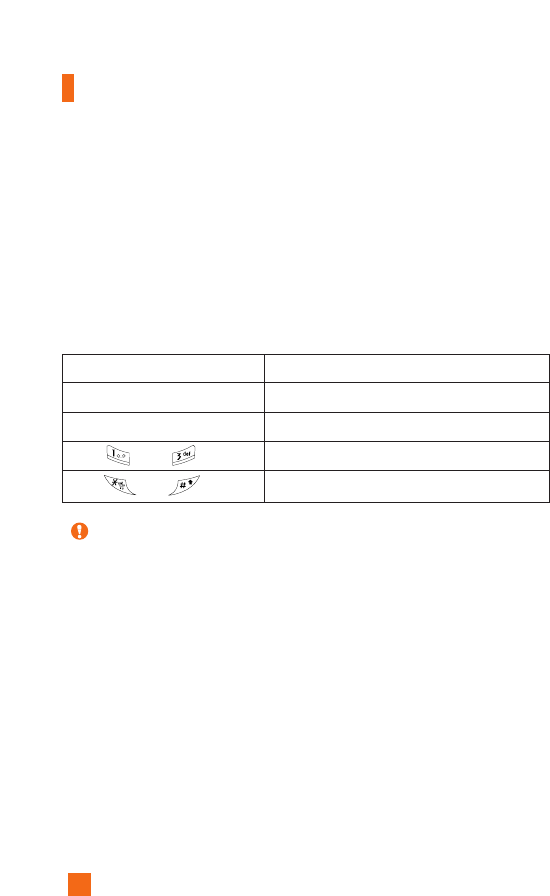
88
My MEdia
Calendar (Menu 7.6.2)
When you enter this menu a calendar will be displayed. Top of the screen
indicates sections for date. Square cursor is used to locate a particular
day. The under bar on the calendar indicates a schedule or memo on that
day. This function helps to remind you of the schedule and memo. The
phone will sound an alarm tone if it has been set for a specific note.
For changing the day, month, and year.
]
View: Press the left soft key [Options] to delete or edit the note you
selected.
]
Edit: Allows you to edit the schedule.
]
Delete: Allows you to delete the schedule.
]
Add New: You can edit maximum of 30 characters and create up to 30
notes.
]
Calendar: Allows you to consult the calendar.
]
Scheduler Tone: The phone can sound an alarm tone when the
scheduled date for an event has been reached with this option.
]
View All Schedules: Shows the notes that are set for all days. Use the
up/down navigation keys to browse through the note lists. You can use
the menu by press the left soft key [Options].
Note Your phone should be switched on to use this function.
Key Description
up/down navigation key
left/right navigation key
key/ key
key/ key
Weekly
Daily
Yearly
Monthly

89
My MEdia
]
Go To Date: Allows you to jump to a specific date.
]
Delete Past: Delete past schedule event that has already been notified.
]
Delete All: Delete all schedules. You are asked to confirm your action.
Voice Recording (Menu 7.6.3)
Allows you to record a memo. You can record up to 3 voice messages
with each message up to 30 seconds.
You can use the Voice Memo feature to:
• Play the recorded voice memos
• Delete one or all voice memos
1. Once recording is started, the message ‘Recording...’ and the remaining
time is displayed.
2. If you want to finish recording, press the left soft key [Save].
]
Play: Allows you to play back all memos recorded, starting with the
most recent memo. The screen displays the date and time when the
memo was recorded.
]
Delete: Allows you to delete a specific memo. All memos recorded are
played back, starting with the most recent one.
]
Record New: Allows you to record a memo.
]
Rename: Allows you to rename a specific memo.
]
Send Via Multimedia Message: Sends the selected voice memo by
MMS.
Note You can see Edit, Delete, View all schedules, Delete past, and Delete
all menus dependent on setting of the schedule.
Note If all memo locations are full, you must delete an old memo before
recording a new one.

90
]
Delete All: Allows you to delete all memos.
Calculator (Menu 7.6.4)
Using this feature, you can use the phone as a calculator. The calculator
provides the basic arithmetic functions: addition, subtraction,
multiplication and division.
Using the Calculator
1. Enter the first number using the numeric keys.
2. Use the navigation keys to select a sign for calculation.
3. To calculate the result, press the left soft key [Result]or key.
Memo (Menu 7.6.5)
To write, edit and delete a memo on a specific date, proceed as follows.
1. Press the left soft key [Add].
2. Input the memo and press the left soft key [Options].
The following options are available.
]
Save: Allows you to save the memo.
]
T9 Languages: Allows you to select the T9 language to use in memo.
]
Exit Editor: Allows you to exit in memo editor.
Or
1. Select a Memo.
2. Press the left soft key [Options].
My MEdia
Note To include a decimal point, press the key.

91
My MEdia
World Time (Menu 7.6.6)
Allows you to check the current Greenwich Mean Time(GMT) and 51
major cities around the world, using the left/right navigation keys.
The screen shows the city name, current date and time.
To select the time zone in which you are located, proceed as follows:
1. Select the city corresponding to your time zone by pressing the left/right
navigation keys one or more times. The local date and time are
displayed.
2. Press the left soft key [Options].
3. If you want to set, press the key.
4. If you want to set Daylight Savings, press the key in
Options menu.
Note The time zone setting of each city in World time menu may be affected
by network condition.
The following options are available.
]
View: Allows you to view the memo.
]
Delete: Allows you to delete the memo. You can press the left soft key
[Options → Delete] to edit the memo displayed.
]
Edit: If you select a memo that already exists, you can press the left soft
key [Options → Edit] to edit the memo displayed.
]
Add New: Add a new memo, up to 20 memos and 40 characters per
each memo.
]
Delete All: Allows you to delete all memos. You are asked to confirm
your action.

92
Unit Converter (Menu 7.6.7)
This converts any measurement into a unit you want.
There are 4 types that can be converted into units: Length, Surface,
Weight, and Volume.
1. You can select one of four unit types by pressing the left soft key [Unit].
2. Select the standard value by using the left/right navigation keys.
3. Select the unit you want to convert by pressing the up/down navigation
keys.
4. You can check the converted value for the unit you want. Also, you can
input a decimal number by pressing the key.
My MEdia

93
Address Book
You can store phone numbers and their corresponding names in the memory
of your SIM card. In addition, you can store up to 255 numbers and names in
the phone memory. The SIM card and phone memories, although physically
separate, are used as if they were a single entity, called the Address Book.
Contact List Menu 8.1
1. When the idle screen is displayed, press the right soft key [Names].
2. Press the left soft key [Select].
3. If you want to edit, delete, copy an entry, or to add the voice to one, select
[Options].
4. Once you have found the required entry, press the to dial the number.
• View Detail: To view in detail the selected name.
• Delete: You can delete an entry.
• Write Text Message: You can write a text message. For further details,
see page 43.
• Write Multimedia Message: You can write a multimedia message. For
further details, see page 54.
• Edit: You can edit the name, mobile number, home number, office
number, E-mail, group, memo and picture by press the left soft key
[Select].
• Copy To Phone: You can copy an entry from SIM to phone.
• Copy To SIM: You can copy an entry from Phone to SIM.
• Voice Tag: You can add voice to the entry or change the voice tag.
• Main Number: You can select the main number out of your mobile, home
or office numbers. Choose the one that is most often used. The main
number will be displayed first, if you set this.

9494
New Contact Menu 8.2
You can add a address book entry by using this function. Phone memory
capacity is 255 entries. SIM card memory capacity depends on the cellular
service provider. You can also save 20 characters of name in the phone
memory, and save characters in the SIM card. The number of characters is
dependent on the SIM.
1. Open the Address Book first by pressing the right soft key [Names] in
standby mode.
2. Scroll to highlight New Contact, and press the left soft key [Select].
3. You can add new address book entries to SIM memory or the address
book memory. To select the memory, go to Set memory (Menu 8.8).
(Refer to page 97.)
• Adding new entries into SIM memory
You can enter a name and number, and select the required group.
(Depends on the SIM)
• Adding new entries into phone memory
You can enter a name, numbers, E-mail address and memo, and select the
required group.
Speed Dials Menu 8.3
You can assign any of the keys, to with a name list entry. You
can call directly by pressing this key for 2-3 seconds.
1. Open the Address Book first by pressing the right soft key [Names] in a
standby mode.
2. Scroll to Speed Dials, then press the left soft key [Select].
3. If you want to add a number to speed dial, select <Empty>. Then, you
can search the name from the Address Book.
Address Book

95
Address Book
4. Select the name from the speed dial. You can change and delete the
name. In addition, you can call by this number, write text message, and
multimedia message.
Voice Tag List Menu 8.4
You can see all the phone numbers which contain voice. You can also call
directly by pressing the key. After selecting the phone number by
using the up/down navigation keys, press the left soft key [Options] and it
will offer the following submenus:
]
Listen: You can play back the voice attached to a phone number.
]
Change: You can change the voice attached to a phone number.
]
Remove: You can delete the voice attached to a phone number.
]
Call: You can call by selecting this submenu.
]
Add New Voice Tag: You can add a new voice to phone number.
]
Remove All: You can delete all the voice attached to a phone number.
Note The voice can only be attached to the main number which you set. For
example, if you change the main number, voice will be automatically
attached to the changed number. This means that you cannot attach
voice to mobile, office and home numbers simultaneously. You can add
a voice tag to a phone number in the SIM card. The voice tag can be
erased if you remove or change the SIM card.

9696
Address Book
Caller Groups Menu 8.5
There are 6 predefined groups as well as one additional group labeled
Others where you can create your own lists.
1. You can set the phone to ring in a specific way and display a preselected
graphic icon when a particular person calls you.
2. Scroll to Caller Groups then press the left soft key [Select] to enter this
menu.
3. Every Group list will be displayed: Family, VIP, Friends, Colleague,
Group 1, Group 2, Others.
4. Select the Group name that you want to manage by pressing
the left soft key [Options].
5. You will see the following submenus under the predefined groups
except for the Others group.
• Member List: Allows you to see the member list in the group.
• Group Ring Tone: Allows you to select the ring tone to be used when
you receive a voice phone call from a person in the group.
• Group Icon: Allows you to select the graphic icon to be displayed
when you receive a call from a person in the group.
• Add Member: Allows you to add the member to the group.
• Delete Member: Allows you to delete the member in the group.
• Rename: Allows you to assign a name to the group.

9797
Address Book
Copy All Menu 8.6
You can copy or move entries from the SIM card memory to the phone
memory and vice versa.
SIM To Phone (Menu 8.6.1)
You can copy the entry from the SIM card to phone memory.
Phone To SIM (Menu 8.6.2)
You can copy the entry from the phone memory to the SIM card.
The following options are available:
]
Keep Original: When copying, Original Dial Number is kept.
]
Delete Original: When copying, Original Dial Number will
be erased.
Delete All Menu 8.7
You can delete all entries in the SIM, Phone and Voice Tag List. This
function requires the security code except for Voice.
Press the key to return to the standby mode.
Set Memory Menu 8.8
Scroll to highlight the Set Memory option, then press the left soft key
[Select].
]
If you select Variable when adding entry, the phone will ask where to
store.
]
If you select SIM or Phone, the phone will store an entry to the SIM or
the phone.

98
Address Book
Information Menu 8.9
Service Dial Number (Menu 8.9.1)
You can view the list of Service Dialing Numbers (SDN) assigned by your
network provider(If supported by the SIM card). Such numbers include the
emergency, directory assistance and voice mail numbers.
1. Select the Service dial number option.
2. The names of the available services will be shown.
3. Use the up/down navigation keys to select a service. Press the key.
Memory Status (Menu 8.9.2)
You can check how many names and numbers are stored in the Address
Book (SIM card and phone memories).
Own Number (Menu 8.9.3)
Allows you to display your phone number in the SIM card.

99
Sounds Menu 9.1
You can use the Sound Settings feature to customize various settings, such
as the:
]
Ring melody, volume and type
]
Sounds made when you press a key, make an error or receive a message
Shop Ringtones (Menu 9.1.1)
This menu option connects to Cingular’s ringtone download site.
Ringtones (Menu 9.1.2)
This option allows you to select the required ring melody. You can choose
between many different melodies. If you have downloaded any sounds
from the Internet or received any ring tone messages, you can view the list
in this menu.
Volume (Menu 9.1.3)
]
Ringtone: To set the volume level for the ringing tones.
]
Key Tone: To set the volume level for keypad tones.
]
Call: This can adjust the volume level.
]
Ear Mic: When using the Ear Mic, volume level can be adjusted.
]
Car Kit: When using the Car Kit, volume level can be adjusted.
Message Alert Tones (Menu 9.1.4)
Select the alert tone for messages.
Key Tones (Menu 9.1.5)
This menu option allows you to select a tone that the phone sounds when
you press a key. You can select an option from Beep and Voice.
Settings

100
Voice Recording (Menu 9.1.6)
For further details, see page 89 (Menu 7.6.3).
Display Menu 9.2
You can change the background image and the display style for Menu
Mode according to your preference.
My Wallpaper (Menu 9.2.1)
This option allows you to change the background image (wallpaper) to be
displayed in idle mode.
To change the background image, proceed as follows.
1. Scroll through the list by pressing the left or right navigation key.
You have various preset images available. You can also select the blank
background and any images downloaded from the Internet.
2. Press the left soft key [Select] when the required image is highlighted.
The selected image is displayed.
Backlight (Menu 9.2.2)
You can select whether or not the phone uses the backlight. A marginal
increase in the standby/talk time can be achieved by turning the backlight off.
Languages (Menu 9.2.3)
You can select the display language. When the language option is set to
Automatic, the language is automatically selected according to the
language of the SIM card used. English will be set if the language on the
SIM card is not supported in the phone.
Settings

101
Settings
Menu Style (Menu 9.2.4)
This option allows you to select the menu display style. You can choose
either Icon style or List style.
Date & Time Menu 9.3
Set Date (Menu 9.3.1)
Allows you to enter the day, month and year. You can change the date
format via the Date Format menu option.
Format: Allows you to change the time and date formats.
Date Format (Menu 9.3.2)
YYYY/MM/DD(year/month/day)
DD/MM/YYYY(day/month/year)
MM/DD/YYYY(month/day/year)
Set Time (Menu 9.3.3)
Allows you to enter the current time. You can choose the time format via
the Time Format menu option.
Time Format (Menu 9.3.4)
24 Hours/12 Hours
Auto Update (Menu 9.3.5)
Select On to set the phone to automatically update the time and date
according to the current time zone.

102
Settings
Call Settings Menu 9.4
To change the settings for call diverting:
Call Forwarding (Menu 9.4.1)
When this network service is activated, you can direct your incoming calls
to another number, for example, to your voice mailbox number. For
details, contact your service provider. Select one of the divert options, for
example, select If busy to divert voice calls when your number is busy or
when you reject incoming calls.
The following options are available:
]
All Voice Calls: Diverts voice calls unconditionally.
]
If Busy: Diverts voice calls when the phone is in use.
]
If No Reply: Diverts voice calls which you do not answer.
]
If Out Of Reach: Diverts voice calls when the phone is switched off or
out of coverage.
]
All Data Calls: Diverts to a number with a PC connection
unconditionally.
]
All Fax Calls: Diverts to a number with a fax connection
unconditionally.
• Activate: Activates the corresponding service.
- To Voice Mail: Forwards to voice mail center. This function does not
include All Data Calls and All Fax Calls menus.
- To Other Number: Inputs the number for diverting.
- Favorite Number: You can check recent five diverted numbers.
• Cancel: Cancels the corresponding service.
• View Status: Checks the status of the service.
]
Cancel All: Cancels all call divert service.

103
Settings
Answer Mode (Menu 9.4.2)
Allows you to determine when to answer the phone.
]
Slide Open: When the phone rings, you can answer a call simply by
sliding down the keypad.
]
Any Key: You can answer an incoming call by pressing any key, except
the key.
]
Send Key Only: You can answer an incoming call by only pressing the
key.
Send My Number (Menu 9.4.3)
This network service allows you to set your phone number to be displayed
(On) or hidden (Off) from the person to whom you are calling. Select Set
By Network to reset the phone to the setting that you have agreed upon
with your service provider.
Call Waiting (Menu 9.4.4)
The network will notify you of a new incoming call while you have a call
in progress. Select Activate to request the network to activate call waiting,
Cancel to request the network to deactivate call waiting, or View Status,
to check if the function is active or not.
Minute Minder (Menu 9.4.5)
This option allows you to specify whether the phone must beep every minute
during an outgoing call to keep you informed of the length of the call.
Voice Dial (Menu 9.4.6)
You can make a phone call by saying a voice tag that has been added to a
contact card. Any spoken word(s) can be a voice tag. Before using voice
dialing, note that:

104
Settings
• Voice tags are not language dependent. They are dependent on the
speaker’s voice.
• Voice tags are sensitive to background noise. Record them and make
calls in a quiet environment.
• When recording a voice tag or making a call by using a voice tag, the
loudspeaker is in use. Hold the phone at a short distance away from your
mouth and face so that the proximity sensor does not turn the loudspeaker
off.
• Very short names are not accepted. Use long names and avoid similar
names for different numbers.
]
Automatic: You can enter the voice dial mode whenever you open the
slide.
]
Manual: You can enter the voice dial mode by holding down the
key.
Auto Redial (Menu 9.4.7)
Select On, and your phone will make a maximum of three attempts to
connect the call after an unsuccessful call attempt.
Closed User Group (Menu 9.4.8)
Closed user group is a network service that specifies the group of people
whom you can call and who can call you. For more information contact
your network operator or service provider. If a group index is specified, it is
used for all outgoing calls. If no group index is specified, the network will
use the preferential index (a specific index that is stored in the network).
]
Preset: Setting the selected CUG Index.
Note You must say the name exactly as you said when you recorded it. This
may be difficult in, for example, a noisy environment or during an
emergency, so you should not rely solely upon voice dialing in all
circumstances.
*
*:Shown only if supported by SIM card

105
Settings
]
On: Activating and editing the CUG Index.
]
Off: Deleting the selected CUG.
TTY (Menu 9.4.9) - Not Support
The majority of users are Deaf, but commonly, a TTY is also used by Hard
of Hearing, Speech Impaired, and even Deaf and Blind individuals. When
you use a TTY, only one person can type at a time, and you should not
interrupt the other. Keep your sentences short and right to the point. If at
all possible, have a printer to facilitate your life. Try to avoid asking too
many questions at once.
Send DTMF (Menu 9.4.0)
You can send the DTMF (dual tone multi-frequency) tones of the number
on the display during a call.
This option is helpful for entering a password or account number when you
call an automated system, like a banking service.
Note Use only PN421-003402 cable.
TTY users must have a TTY/TDD device.
TTY: Tele Type writer
TTD: Telecommunication Device for the Deaf

106
Settings
Security Menu 9.5
Various codes and passwords are used to protect the features of your
phone. They are described in the following sections (see pages 24)
PIN Code Request (Menu 9.5.1)
When the PIN code request feature is enabled, you must enter your PIN
each time you switch the phone on. Consequently, any person who does
not have your PIN cannot use your phone without your approval.
The following options are available:
]
Enable: You must enter the PIN each time the phone is switched on.
]
Disable: The phone connects directly to the network when you switch it
on.
Fixed Dial Number (FDN) (Menu 9.5.2)
Allows you to restrict your outgoing calls to selected phone numbers, if
this function is supported by your SIM card. The PIN2 code is required.
The following options are available:
]
Enable: You can only call phone numbers stored in the Address Book.
You must enter your PIN2.
]
Disable: You can call any number.
]
Number List: You can view the number list saved as fixed dial number.
Note Before disabling the PIN code request feature, you must enter your PIN
Note Not all SIM cards have a PIN2. If your SIM card does not, this menu
option is not displayed.

107
Settings
Change Codes (Menu 9.5.3)
The Change codes feature allows you to change your current password to a
new one. You must enter the current password before you can specify a
new one.
You can change the access codes: Security Code, PIN1 Code, PIN2 Code
Connection Menu 9.6
Network Selection (Menu 9.6.1)
The Network Selection feature enables you to indicate whether the network
used when roaming(outside your home area) is selected Automatic,
Manual, and Preferred.
]
Automatic: Allows you to set the phone to automatically search for and
select one of the cellular networks available in your area.
The phone will be set to Automatic even though the power is off and
on.
]
Manual: Allows you to select the desired network manually from a list
of networks. If the connection to the manually selected network is lost,
the phone will sound an error tone and ask you to select a network
again. The selected network must have a roaming agreement with your
home network, that is, the operator whose SIM card is in your phone.
The phone lets you select another network if the phone fails to access
the selected network. If you switch off the phone, the phone will be reset
to Automatic.
]
Preferred: You can set a list of preferred networks the handset should
attempt to register with first, before attempting to register to any other
networks. This list is created from the handset’s predefined list of
known networks.
Note PIN: Personal Identification Number.

108108
Settings
World Phone (Menu 9.6.2)
When the America(850/1900) option is selected the device can be used in
the US, and when the Europe(1800) option is chosen the device can be
used in European countries.
GPRS Attach (Menu 9.6.3)
If you select Power On and you are in a network that supports packet data,
the phone registers to the GPRS network and sending short messages will
be done via GPRS. Also, starting an active packet data connection, for
example, to send and receive e-mail, is quicker. If you select When
Needed, the phone will use a packet data connection only if you start an
application or action that needs it. The GPRS connection is closed after it
is not used by any application.
Access Point (Menu 9.6.4)
This feature sets the Profile during the WAP and MMS connections.
Please see page 69 for further detail. The Profile menu under the Access
Point feature will display Add, Delete and Editor options, but the reason
why Activate option is not available is because there is no way of knowing
whether WAP or MMS will be used to activate the content.
Reset Access Point (Menu 9.6.5)
This allows Profile information to be restored to original setting. For
example, this option will restore the Profile that has been deleted by the
Delete All selection from the Access Point (Menu 4.4) submenu.
Note The US frequency is set at 850/1900 MHz and the European frequency
is set at 1800 MHz.
Note If there is no GPRS coverage and you have chosen Power on, the
phone will periodically try to establish a packet data connection.

109
Settings
Reset Setting Menu 9.7
You can easily reset your phone to its default configuration. To do so,
proceed, as follows.
1. Select the Reset Settings menu option.
2. Enter the 4-digit phone password.
Note The password is preset to 0000.

110
Please check to see if any problems you have encountered with the phone
are described in this section before taking the phone in for a service or
calling a service engineer.
QHow do I view the list of outgoing calls, incoming calls and missed
calls?
APress the key.
QHow do I clear all call history?
APress the left soft key[Menu] and then the key.
QHow do I view all numbers stored in memory?
APress right soft key[Names] and then .
QWhy is the connection inconsistent or not audible in certain areas?
AWhen frequency environment is unstable in a certain area, connection
may be inconsistent and not audible. Relocate to another area and try
again.
QWhy is the connection not consistent abruptly disconnects even when
established?
A When frequency is unstable or weak or if there are too many users,
connection may be cut off even after it was established. Please try again
later or attempt after relocating to other areas.
Q&A

111
Q&A
QWhy does the LCD not turn on?
A Remove the battery and turn on the power after placing it back on. If
there is no change, fully charge the battery and try again.
Q Why is there an echo when a connection is made with certain
telephones in a certain area?
AThis is called the ‘Echo Phenomenon’, where it occurs if connection
volume is too high or caused by special properties (semi electronic
telephone exchange) of the equipment on the other end.
QWhy does the phone heat up?
AThe phone may get hot when there is a very long call duration or when
games are played or even when surfing the Internet for a long time. This
has no effect upon the life of the product or performance.
QWhy is there no ring tone, but only a blinking LCD screen?
APhone may be set to ‘Vibration All’ or in ‘Silent All’ mode. In the
Sound menu, please select Volume →Ringtone →Volume 1 ~ Volume
5, or Vol5&Vib.
Q Why does the battery life get shorter in standby mode?
A The battery is worn out. As time passes, the battery life gradually
becomes shorter. If the battery lasts about half the amount of time as
when first purchased, it’s time to purchase a new battery.

112
Q&A
QWhy does the battery run out so quickly during normal use?
AIt is due to the user environment or a large number of calls or weak
signal.
QWhy is no number dialed when you recall a Address Book entry?
A Check that the number has been stored correctly by using the Address
book Search feature. Re-store them, if necessary.
QWhy can’t my correspondent reach me?
A Is you phone switched on ( pressed for more than three seconds)?
Are you accessing the right cellular network? Or, you may have set an
incoming call barring option.
QI cannot find the lock, PIN, or PUK code. What is my password?
A The default lock code is ‘0000’. If you forget or lose the lock code,
contact your phone dealer. If you forget or lose a PIN or PUK code, or
if you have not received such a code, contact your network service
provider

113
TIA Safety Information
Provided herein is the complete TIA Safety Information for Wireless
Handheld phones. Inclusion of the text covering Pacemakers, Hearing
Aids, and Other Medical Devices is required in the owner’s manual for
CTIA Certification. Use of the remaining TIA language is encouraged
when appropriate.
Exposure to Radio Frequency Signal
Your wireless handheld portable telephone is a low-power radio
transmitter and receiver. When it is ON, it receives and also sends out
radio frequency (RF) signals.
In August, 1996, the Federal Communications Commissions (FCC)
adopted RF exposure guidelines with safety levels for handheld wireless
phones. Those guidelines are consistent with the safety standards
previously set by both U.S. and international standards bodies:
ANSI C95.1 (1992) *
NCRP Report 86 (1986)
ICNIRP (1996)
Those standards were based on comprehensive and periodic evaluations of
the relevant scientific literature. For example, over 120 scientists,
engineers, and physicians from universities, government health agencies,
and industry reviewed the available body of research to develop the ANSI
Standard (C95.1).
*American National Standards Institute; National Council on Radiation
Protection and Measurements; International Commission on Non-Ionizing
Radiation Protection
The design of your phone complies with the FCC guidelines (and those
standards).
Antenna Care
Use only the supplied or an approved replacement antenna. Unauthorized
antennas, modifications, or attachments could damage the phone and may
violate FCC regulations.
Safety Guidelines

114
Phone Operation
NORMAL POSITION: Hold the phone as you would any other telephone
with the antenna pointed up and over your shoulder.
Tips on Efficient Operation
For your phone to operate most efficiently:
]
Do not touch the antenna unnecessarily when the phone is in use.
Contact with the antenna affects call quality and may cause the phone to
operate at a higher power level than otherwise needed.
Driving
Check the laws and regulations on the use of wireless phones in the areas
where you drive. Always obey them. Also, if using your phone while
driving, please:
]
Give full attention to driving — driving safely is your first
responsibility;
]
Use hands-free operation, if available;
]
Pull off the road and park before making or answering a call if driving
conditions so require.
Electronic Devices
Most modern electronic equipment is shielded from RF signals. However,
certain electronic equipment may not be shielded against the RF signals
from your wireless phone.
Pacemakers
The Health Industry Manufacturers Association recommends that a
minimum separation of six (6’) inches be maintained between a handheld
wireless phone and a pacemaker to avoid potential interference with the
pacemaker. These recommendations are consistent with the independent
research by and recommendations of Wireless Technology Research.
Safety Guidelines

115
Safety Guidelines
Persons with pacemakers:
]
Should ALWAYS keep the phone more than six inches from their
pacemaker when the phone is turned ON;
]
Should not carry the phone in a breast pocket.
]
Should use the ear opposite the pacemaker to minimize the potential for
interference.
]
If you have any reason to suspect that interference is taking place, turn
your phone OFF immediately.
Hearing Aids
Some digital wireless phones may interfere with some hearing aids. In the
event of such interference, you may want to consult your service provider.
Other Medical Devices
If you use any other personal medical device, consult the manufacturer of
your device to determine if they are adequately shielded from external RF
energy. Your physician may be able to assist you in obtaining this
information.
Turn your phone OFF in health care facilities when any regulations posted
in these areas instruct you to do so. Hospitals or health care facilities may
be using equipment that could be sensitive to external RF energy.
Vehicles
RF signals may affect improperly installed or inadequately shielded
electronic systems in motor vehicles. Check with the manufacturer or its
representative regarding your vehicle.
You should also consult the manufacturer of any equipment that has been
added to your vehicle.
Posted Facilities
Turn your phone OFF in any facility where posted notices so require.

116
Safety Guidelines
Aircraft
FCC regulations prohibit using your phone while in the air. Turn your
phone OFF before boarding an aircraft.
Blasting Areas
To avoid interfering with blasting operations, turn your phone OFF when
in a ‘blasting area’ or in areas posted: ‘Turn off two-way radio’. Obey all
signs and instructions.
Potentially Explosive Atmosphere
Turn your phone OFF when in any area with a potentially explosive
atmosphere and obey all signs and instructions. Sparks in such areas could
cause an explosion or fire resulting in bodily injury or even death.
Areas with a potentially explosive atmosphere are often, but not always,
marked clearly. Potential areas may include: fueling areas (such as
gasoline stations); below deck on boats; fuel or chemical transfer or
storage facilities; vehicles using liquefied petroleum gas (such as propane
or butane); areas where the air contains chemicals or particles (such as
grain, dust, or metal powders); and any other area where you would
normally be advised to turn off your vehicle engine.
For Vehicles Equipped with an Air Bag
An air bag inflates with great force. DO NOT place objects, including
either installed or portable wireless equipment, in the area over the air bag
or in the air bag deployment area. If in-vehicle wireless equipment is
improperly installed and the air bag inflates, serious injury could result.

117
To help you understand the main technical terms and abbreviations used in
this booklet and take full advantage of the feature on your mobile phone,
here are a few definitions.
Call Barring
Ability to restrict outgoing and incoming calls.
Call Divert
Ability to reroute calls to another number.
Call waiting
Ability to inform users that they have an incoming call when engaged on
another call.
GPRS (General Packet Radio Service)
GPRS guaranties continuous connection to the Internet for mobile phone
and computer users. It is based on the Global System for Mobile
Communication (GSM) circuit-switched cellular phone connections and
the Short Message Service (SMS).
GSM (Global System for Mobile Communication)
International standard for cellular communication, guaranteeing
compatibility between the various network operators. GSM covers most
European countries and many other parts of the world.
Glossary

118
Java
Programming language generating applications that can run on all
hardware platforms, whether small, medium or large, without modification.
It has been promoted for and geared heavily to the Web, both for public
Web sites and Intranets. When a Java program runs from a Web page, it is
called a Java applet. When it is run on a mobile phone or pager, it is called
a MIDlet.
Line Identification Services (Caller ID)
Service allowing subscribers to view or block the telephone numbers of
callers.
Multiparty Calls
Ability to establish a conference call involving up to five additional parties.
Phone Password
Security code used to unlock the phone when you have selected the option
to lock it automatically each time it switches on.
Roaming
Use of your phone when you are outside your home area (when traveling
for example).
SDN (Service Dial Number)
Telephone numbers supplied by your network provider and giving access
to special services, such as voice mail, directory inquiries, customer
support and emergency services.
Glossary

119
Glossary
SIM (Subscriber Identification Module)
Card containing a chip with all the information required to operate the
phone (network and memory information, as well as the subscriber's
personal data). The SIM card fits into a small slot on the back of the phone
and is protected by the battery.
SMS (Short Message Service)
Network service sending and receiving messages to and from another
subscriber without having to speak to the correspondent. The message
created or received (up to 160 characters long) can be displayed, received,
edited or sent.
DATE: 2004.12.17 (HS)
Patent Information
This product was manufactured under one or more of the following U.S.
patents: 5276765 5749067 6061647